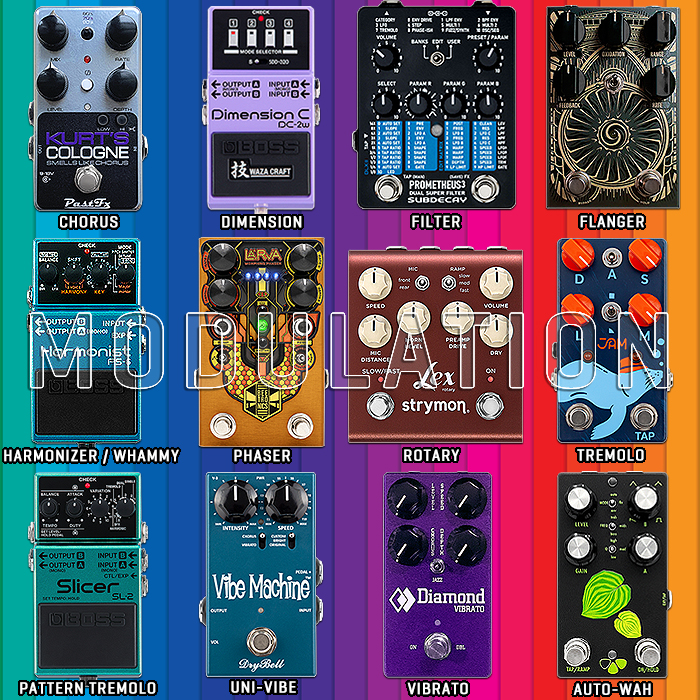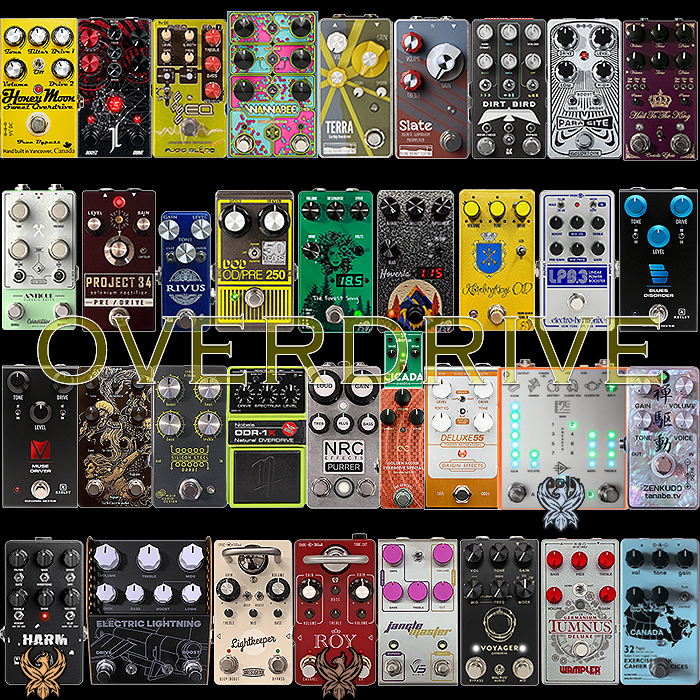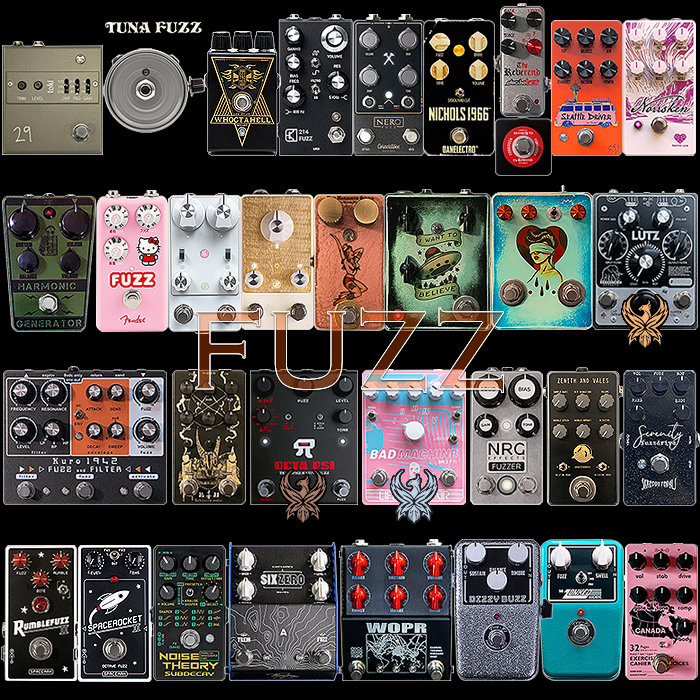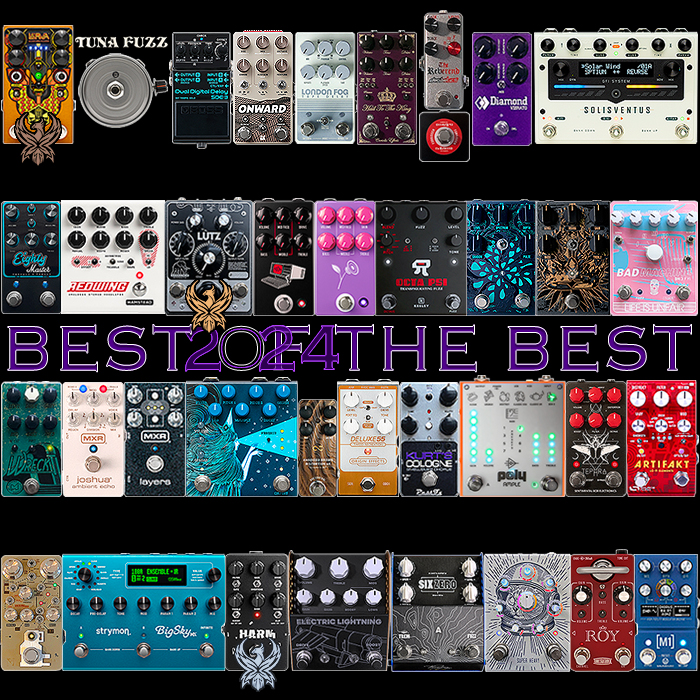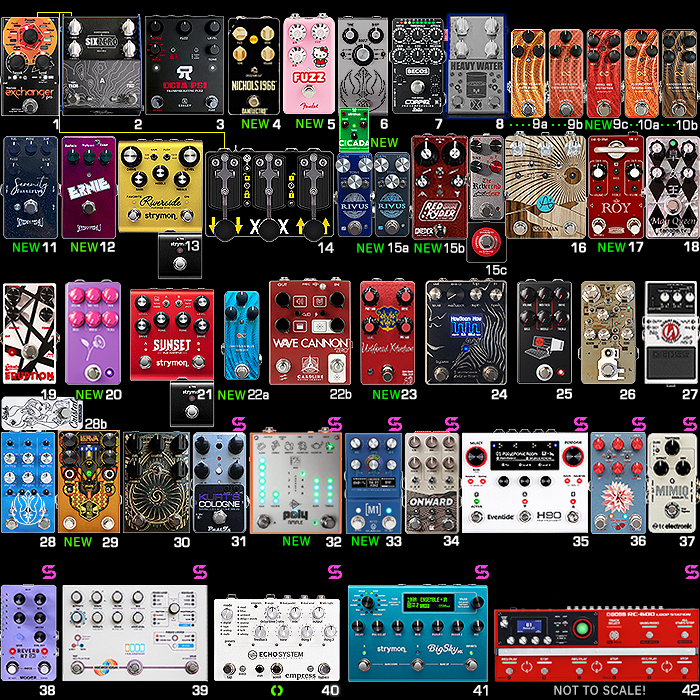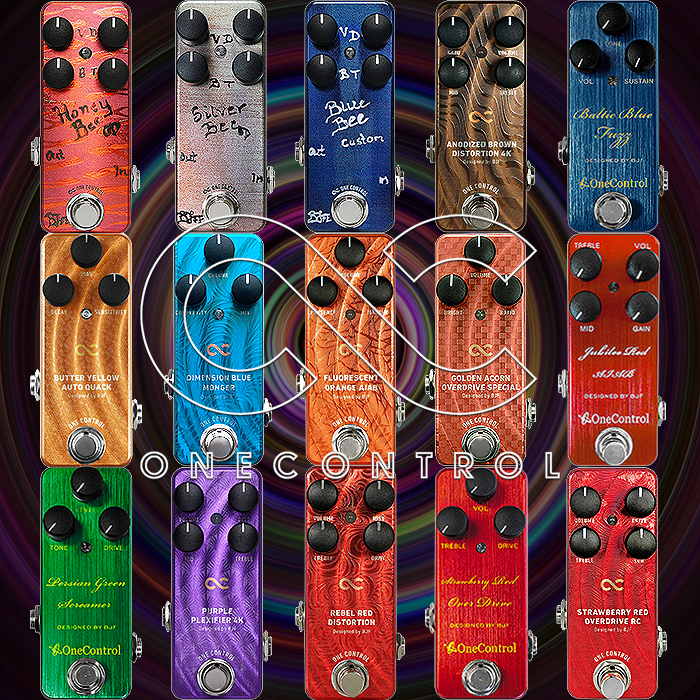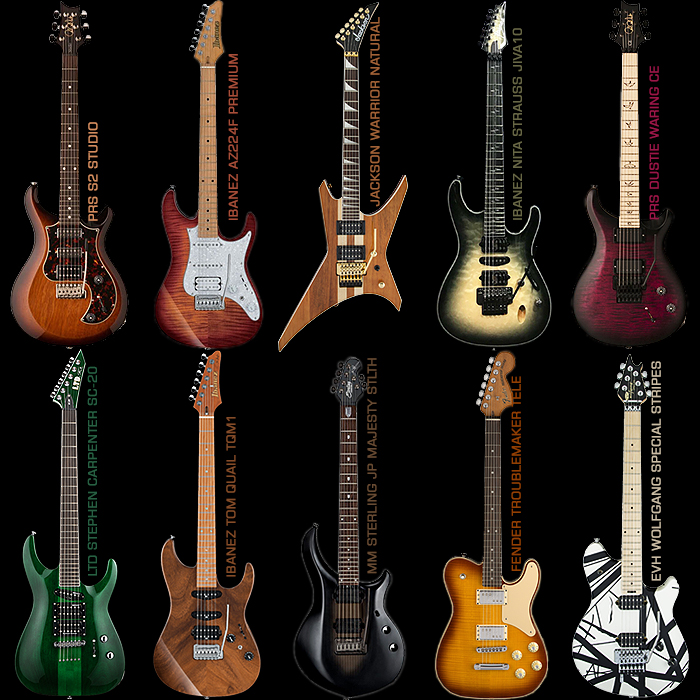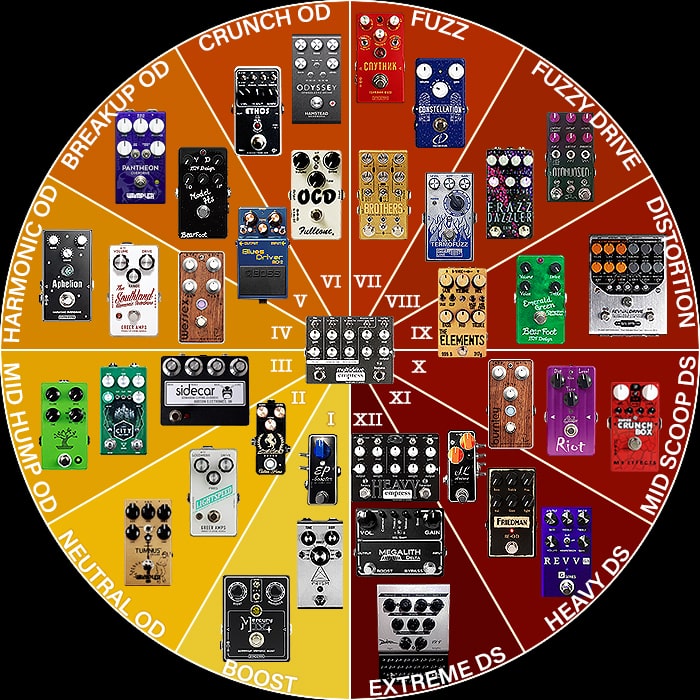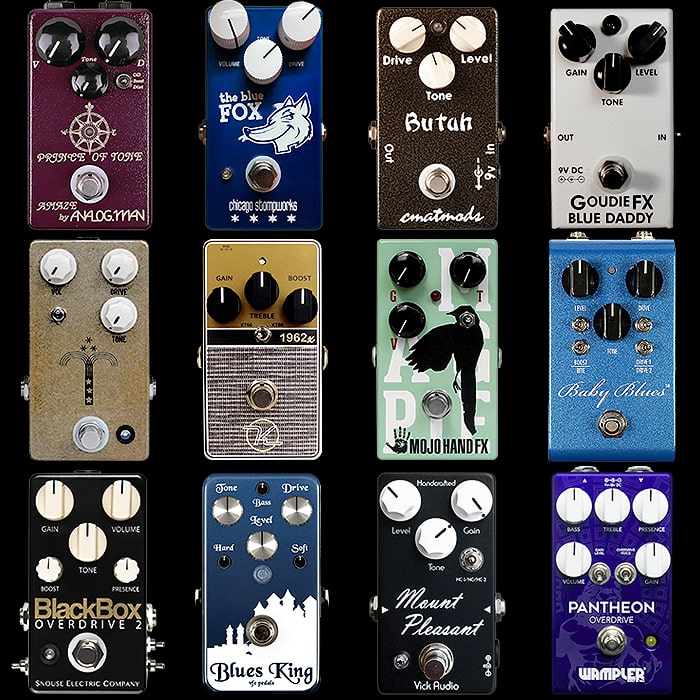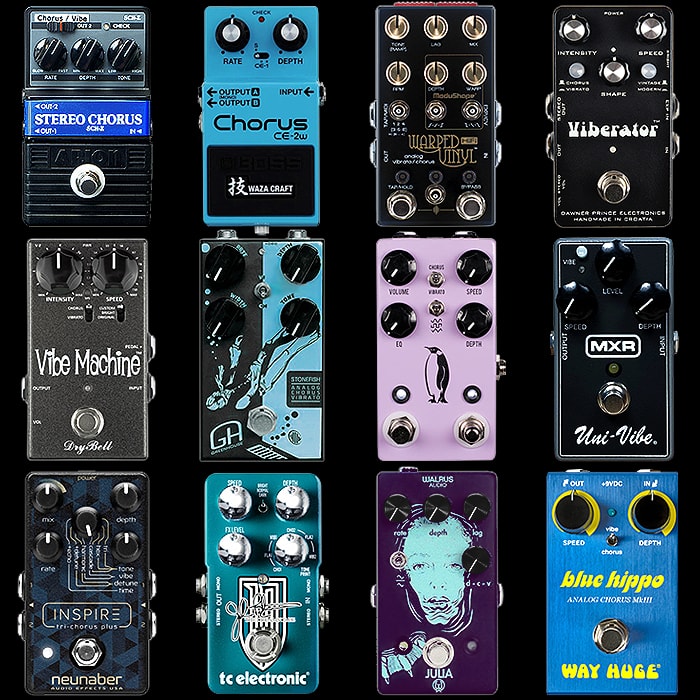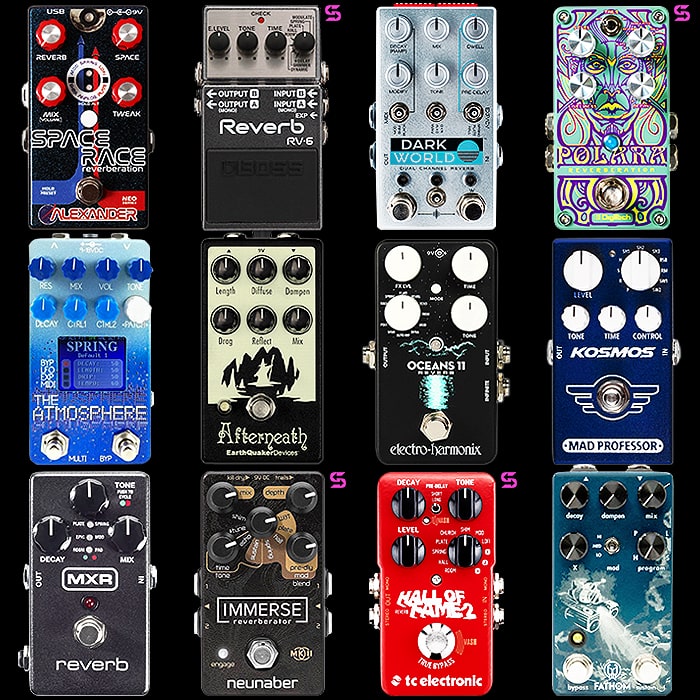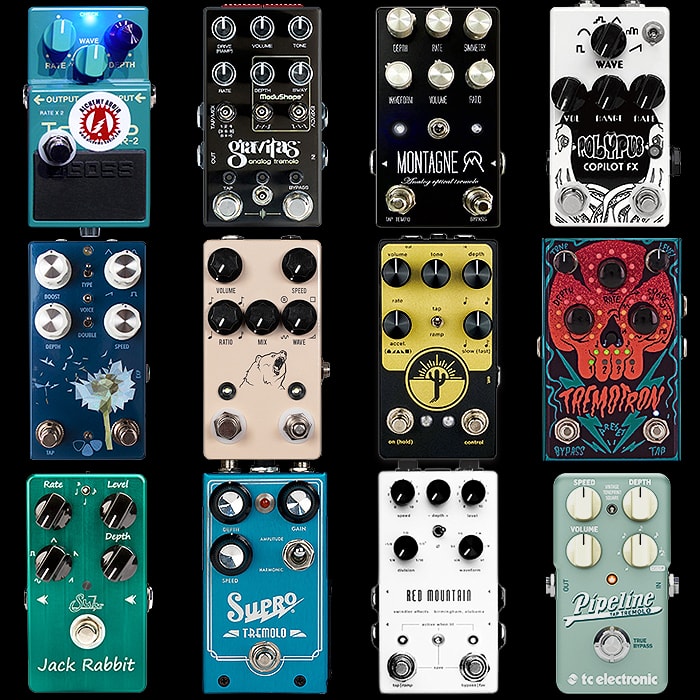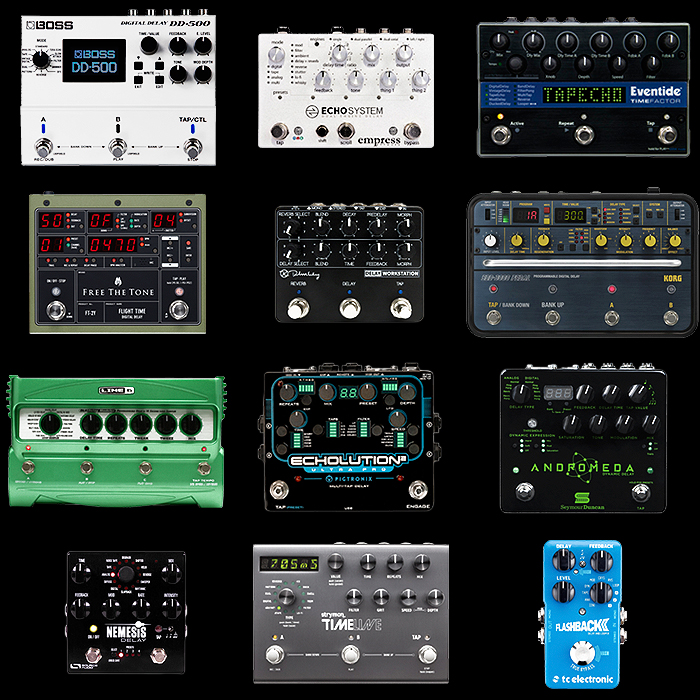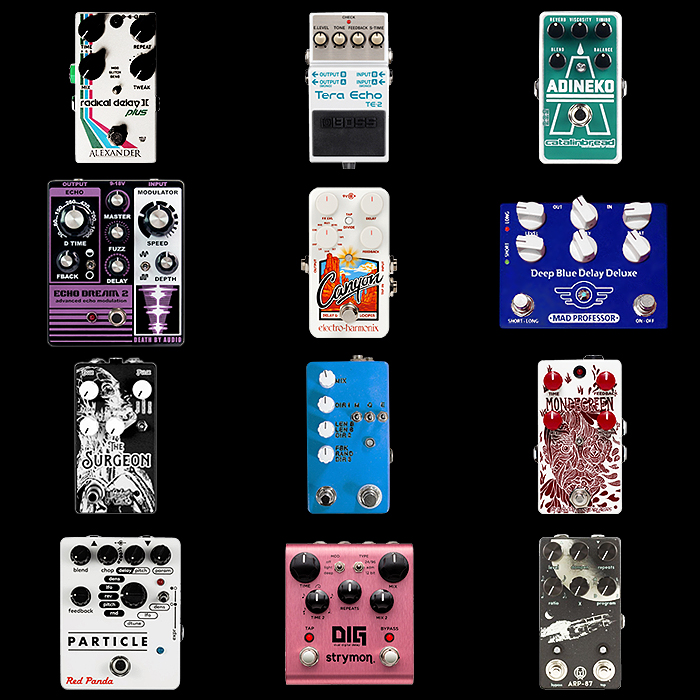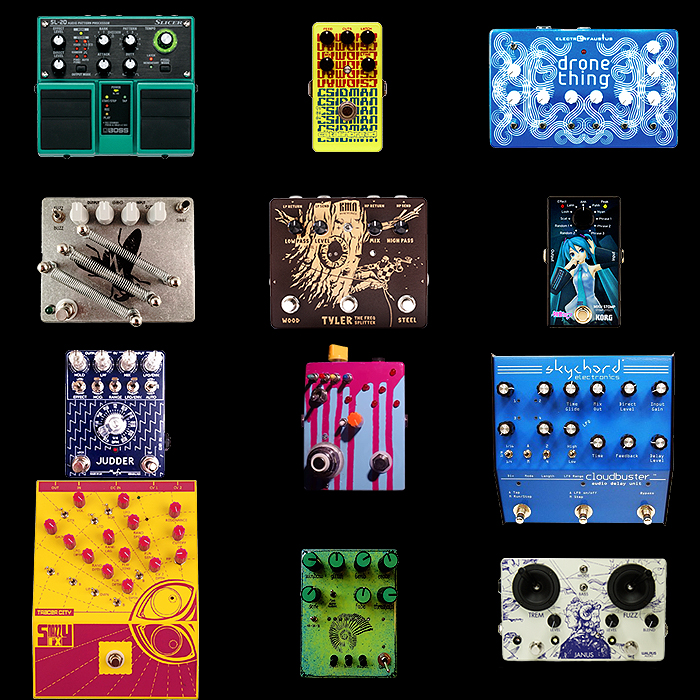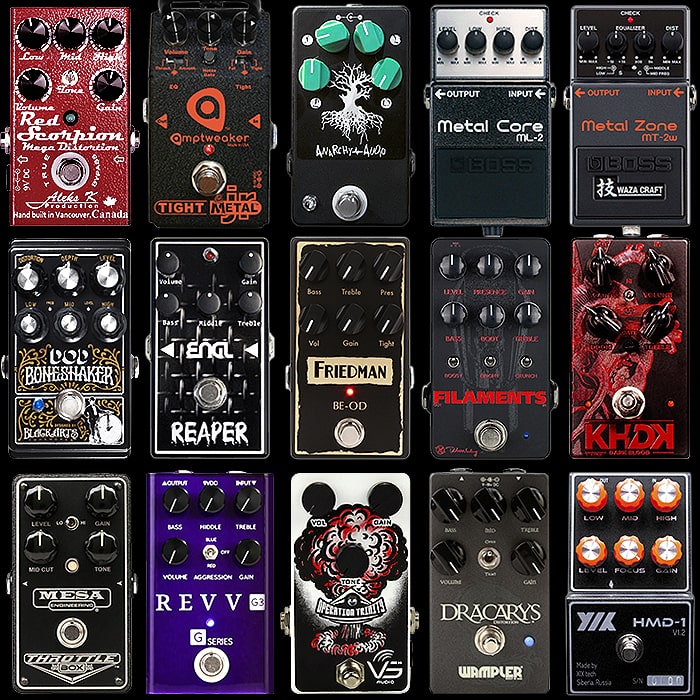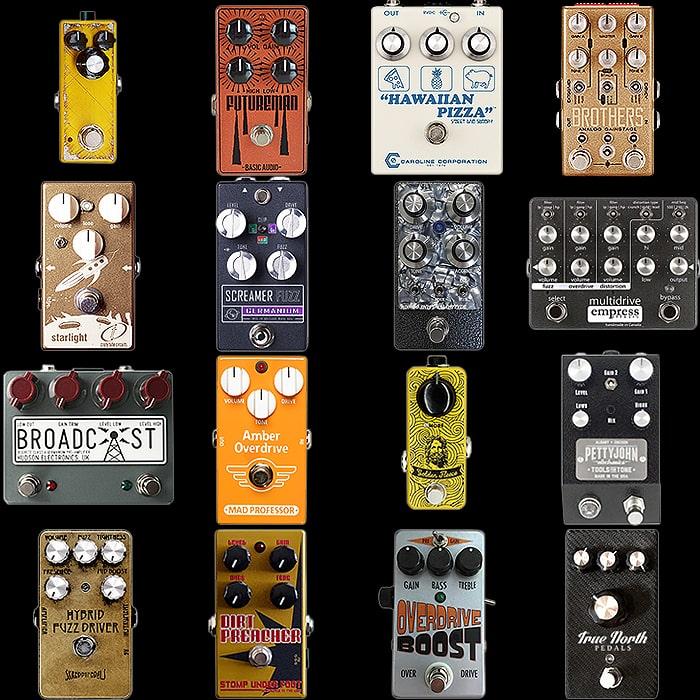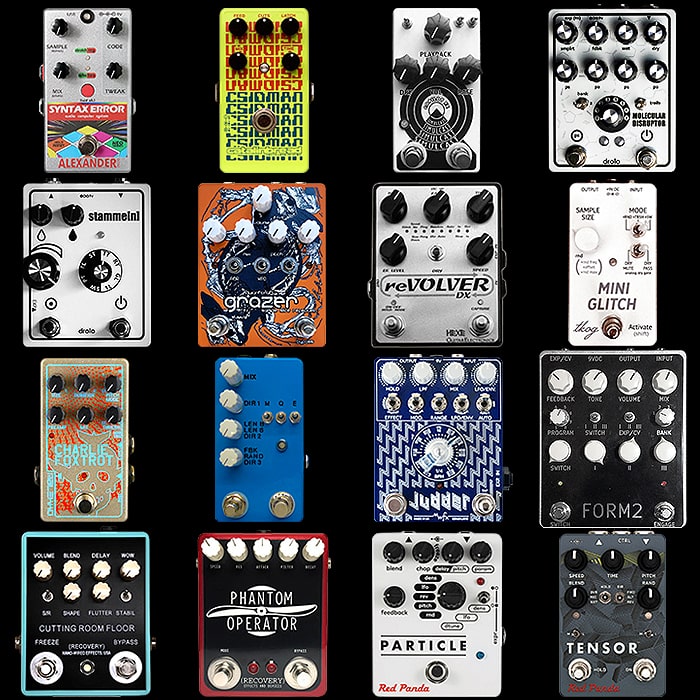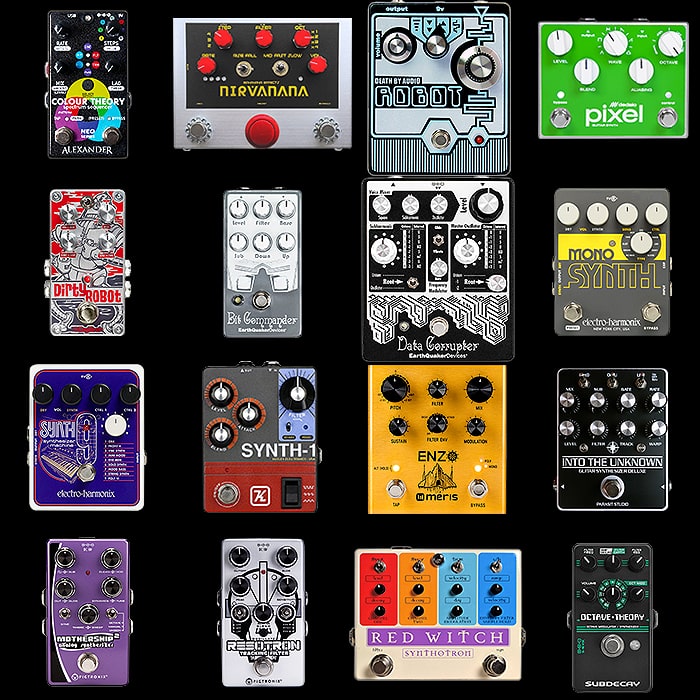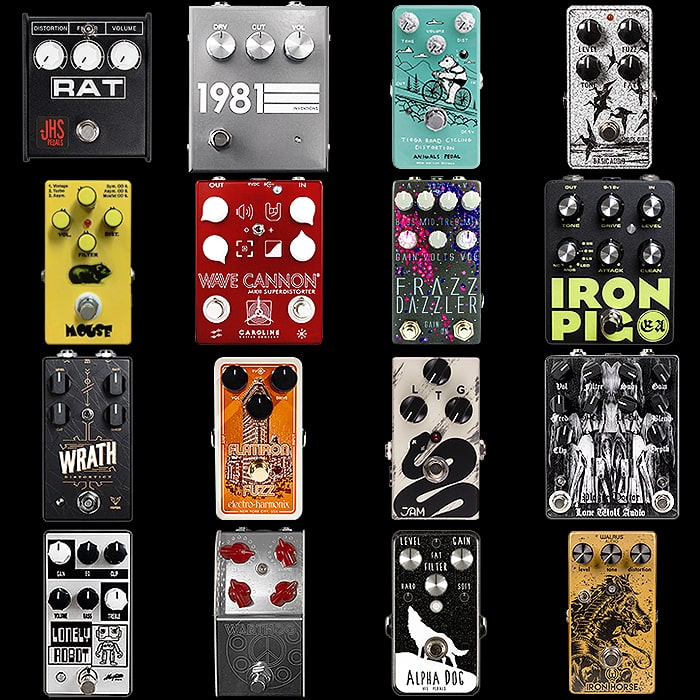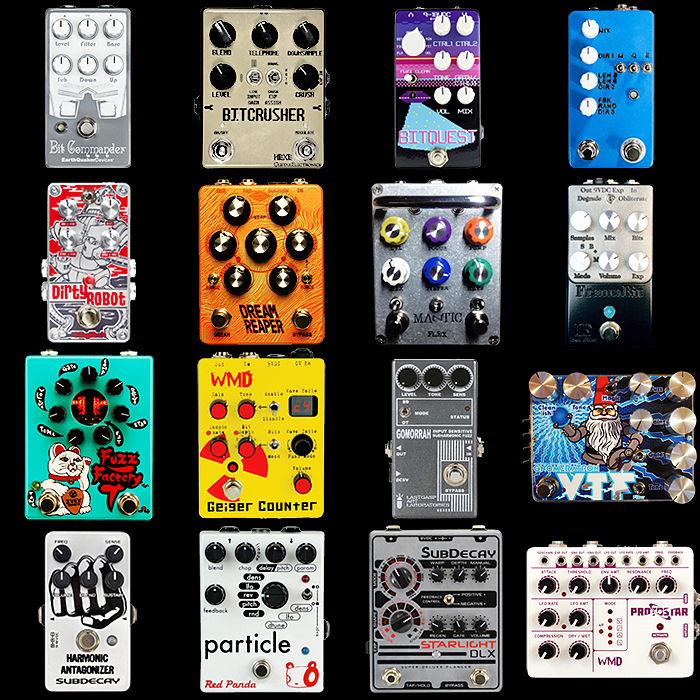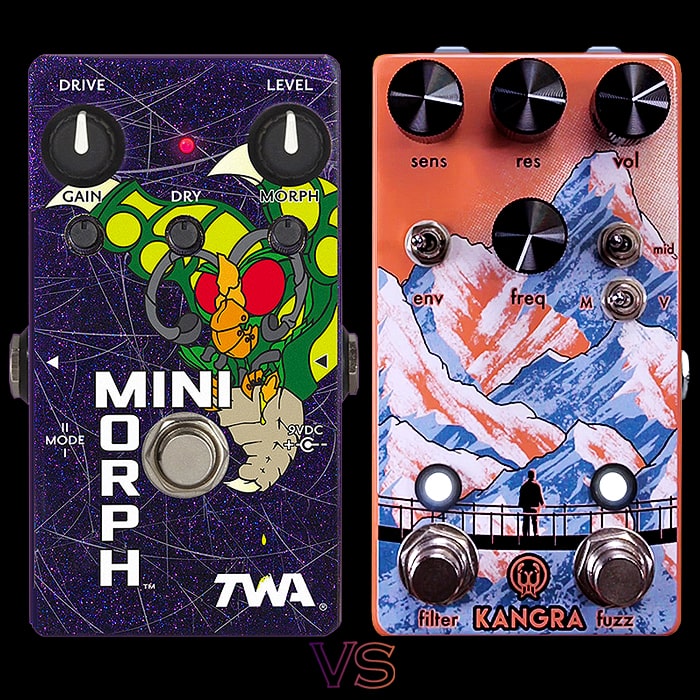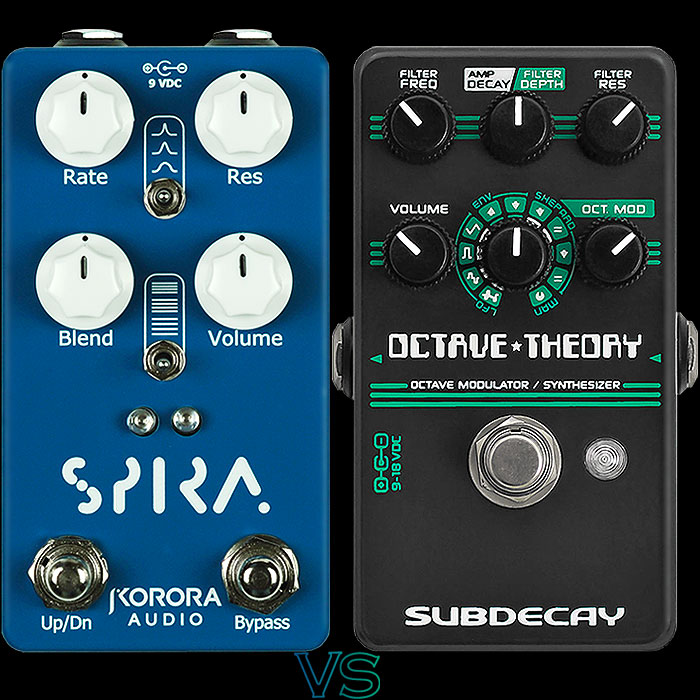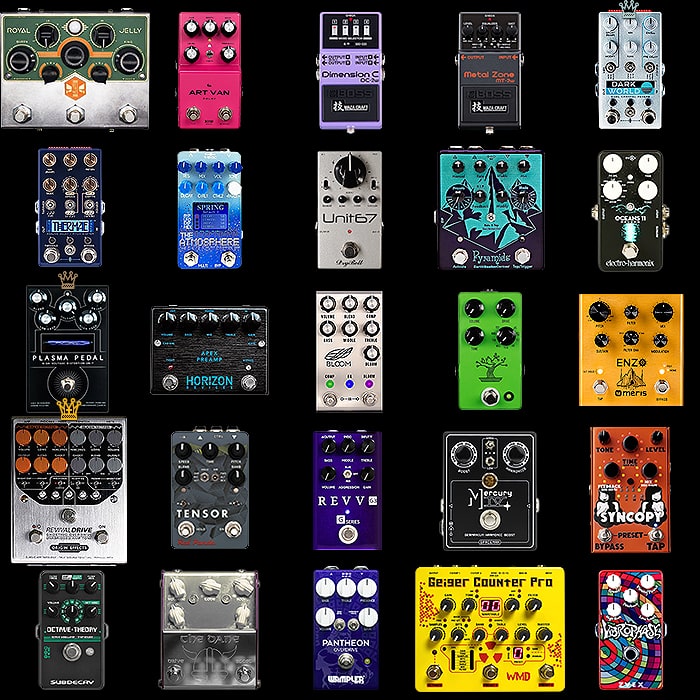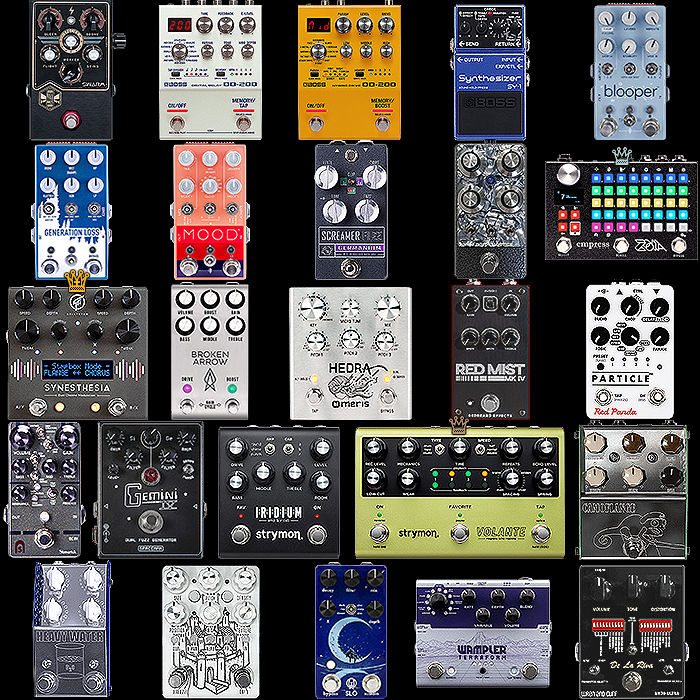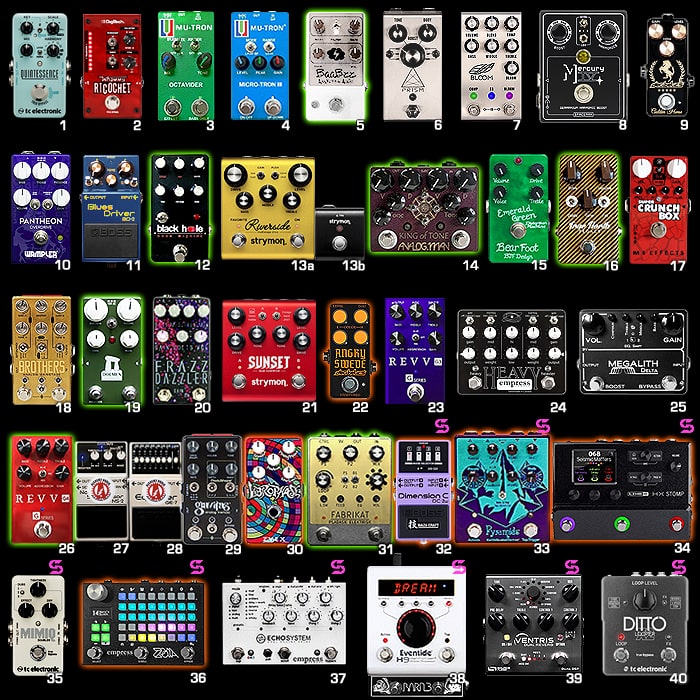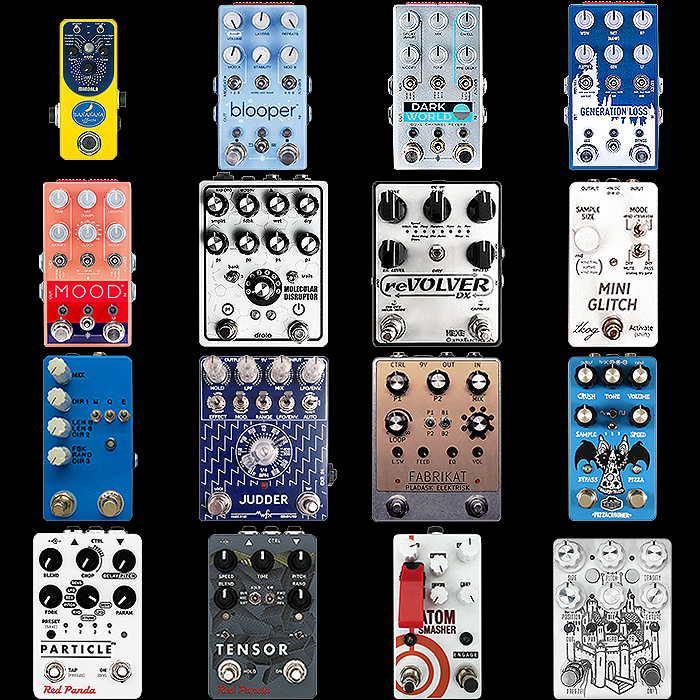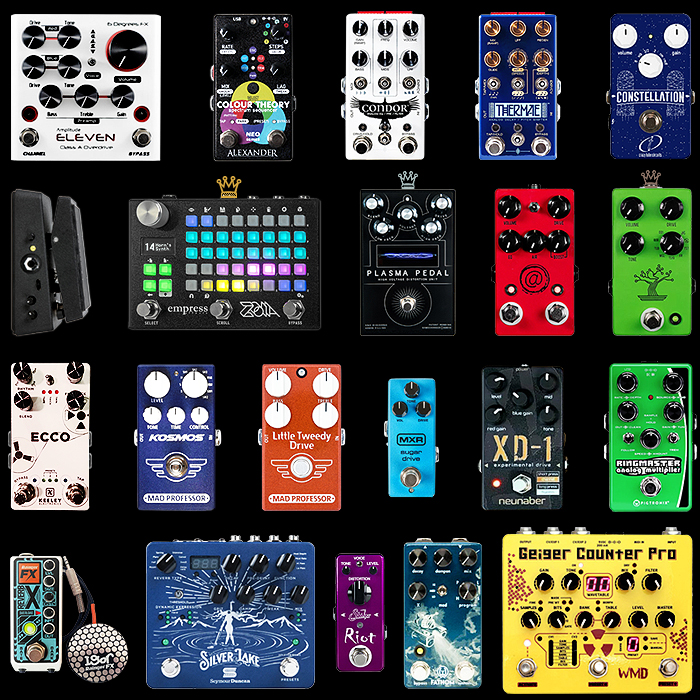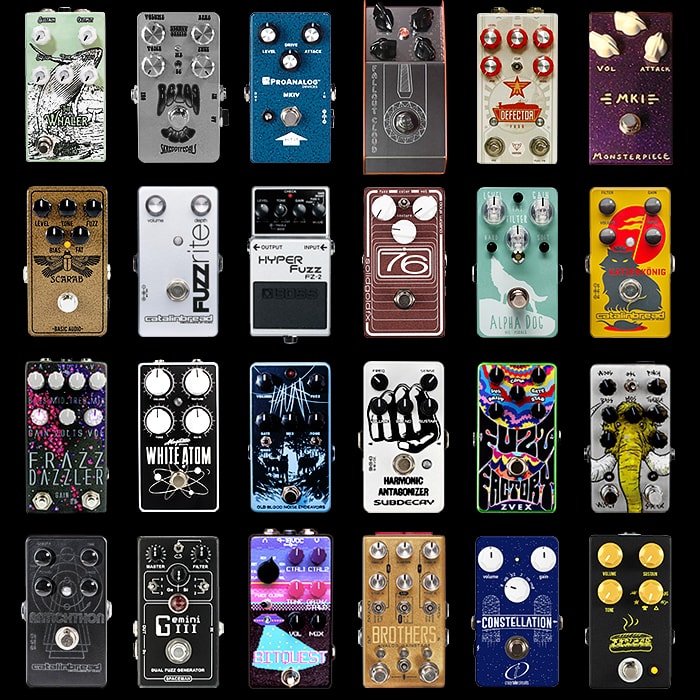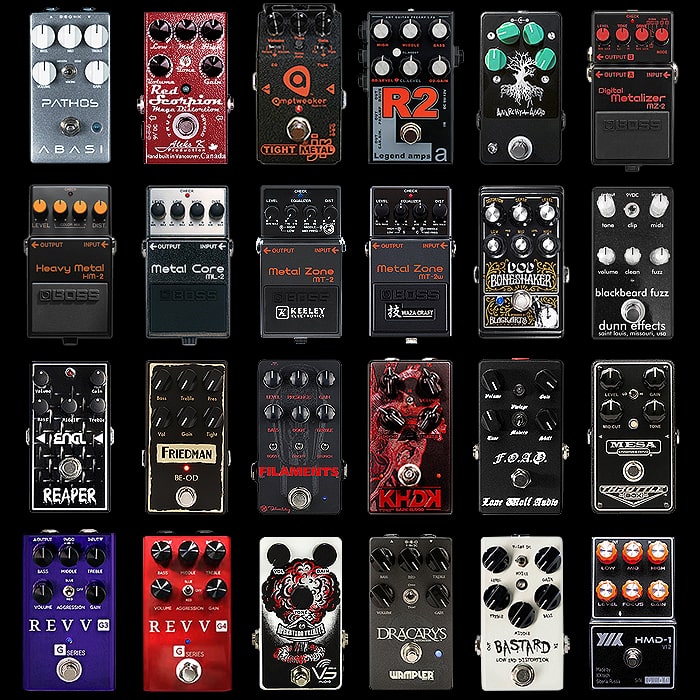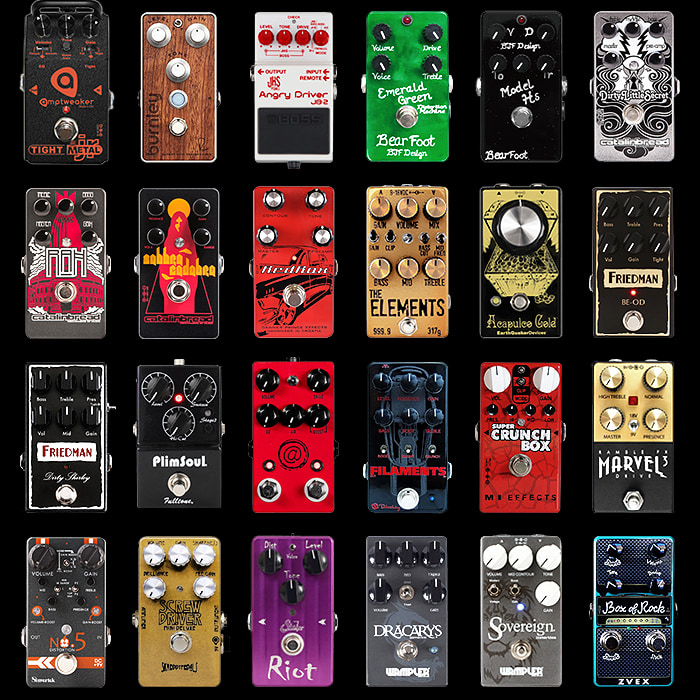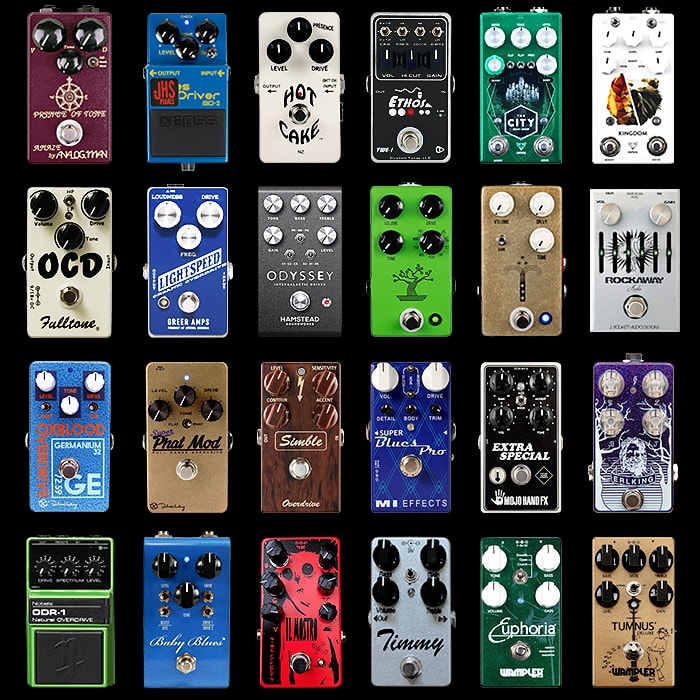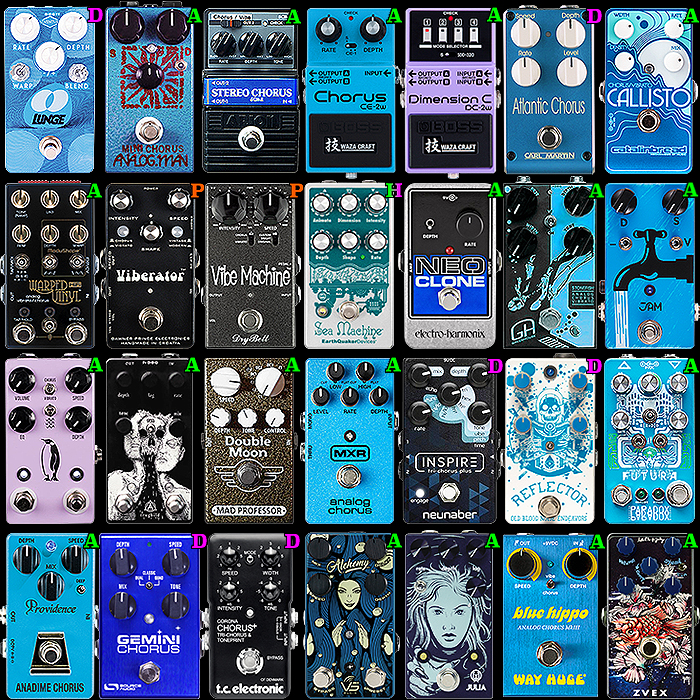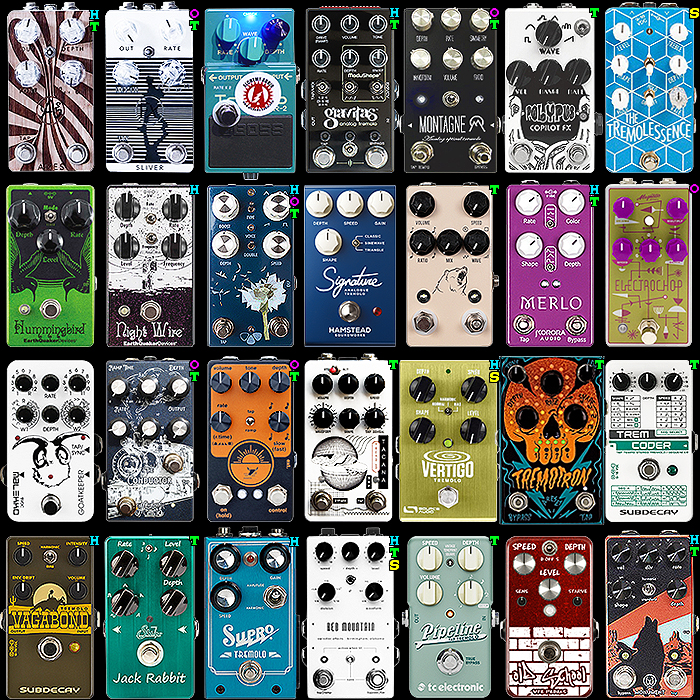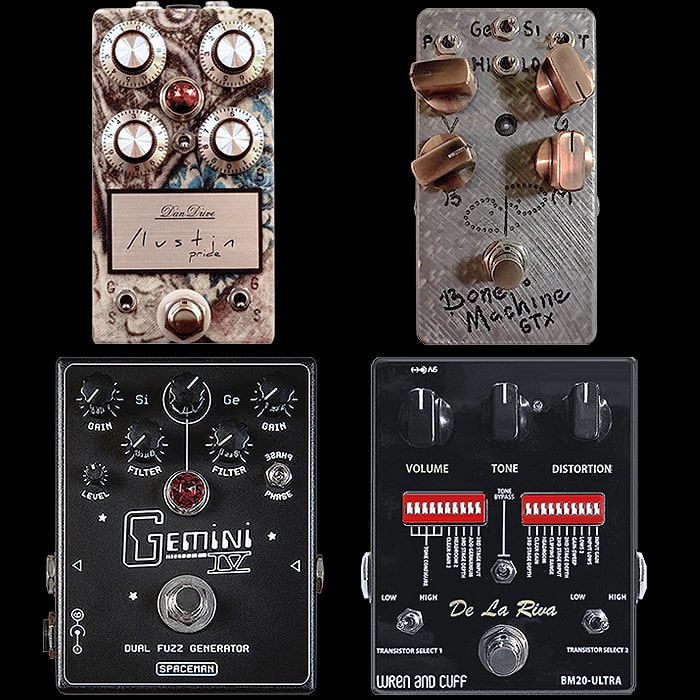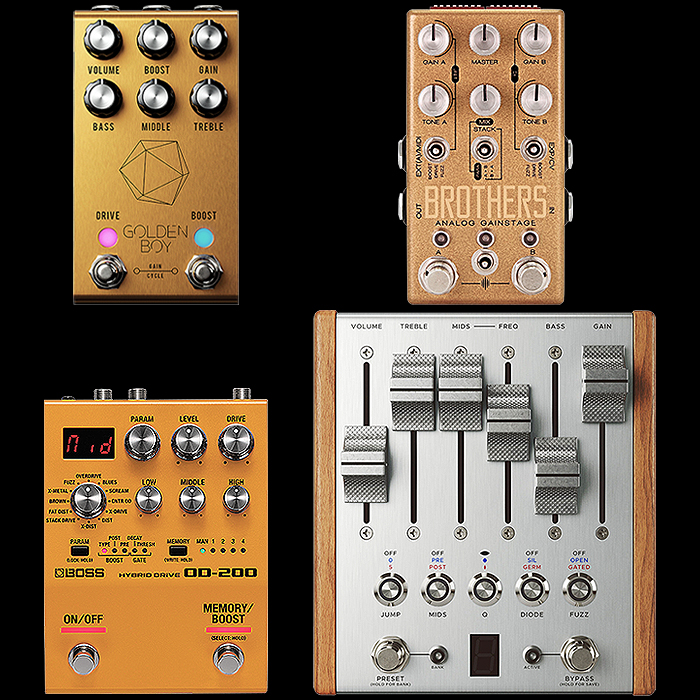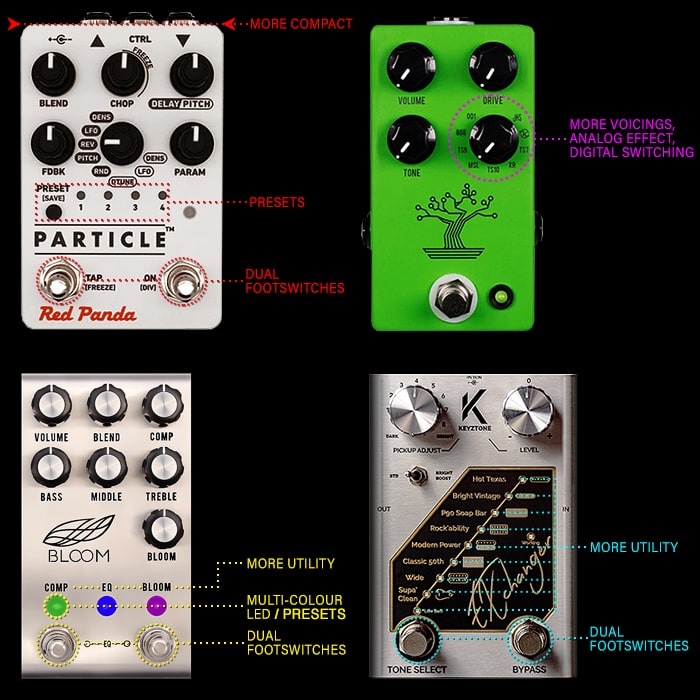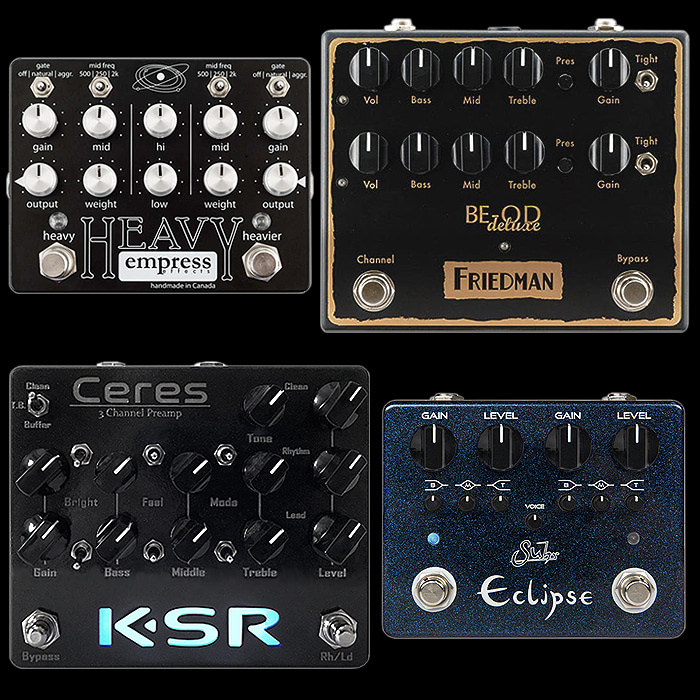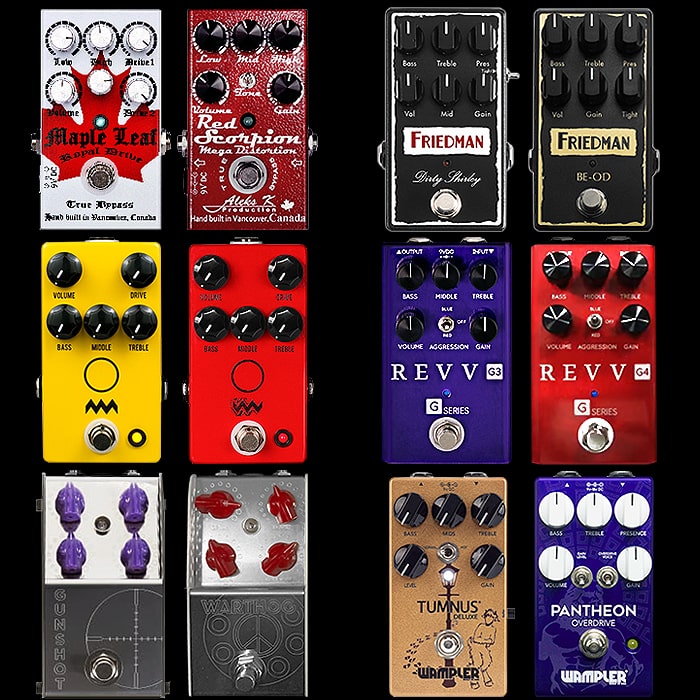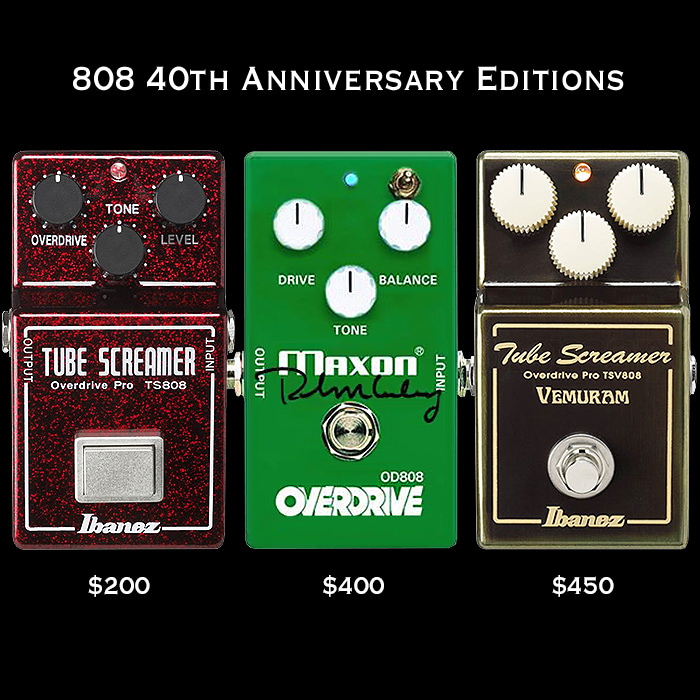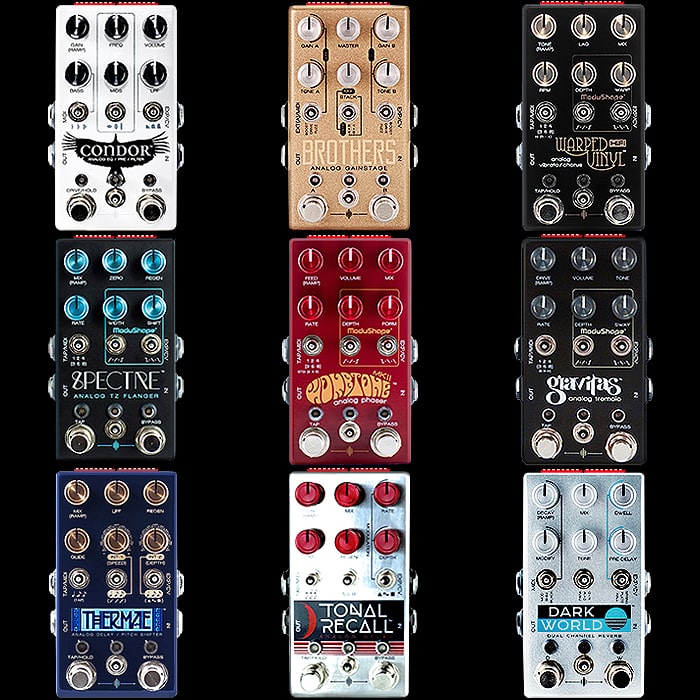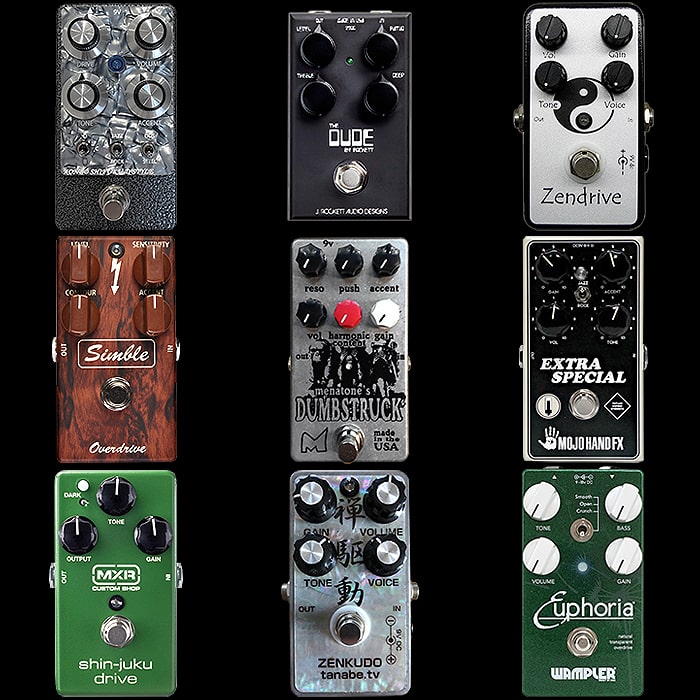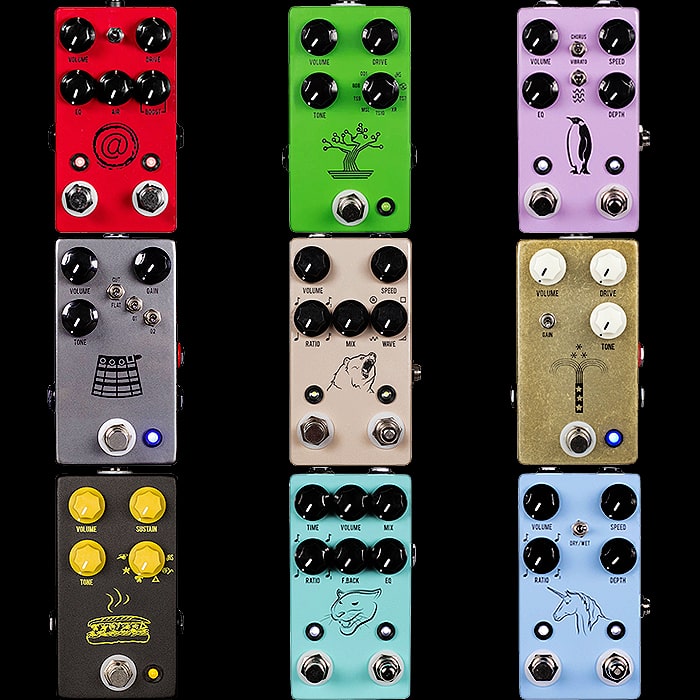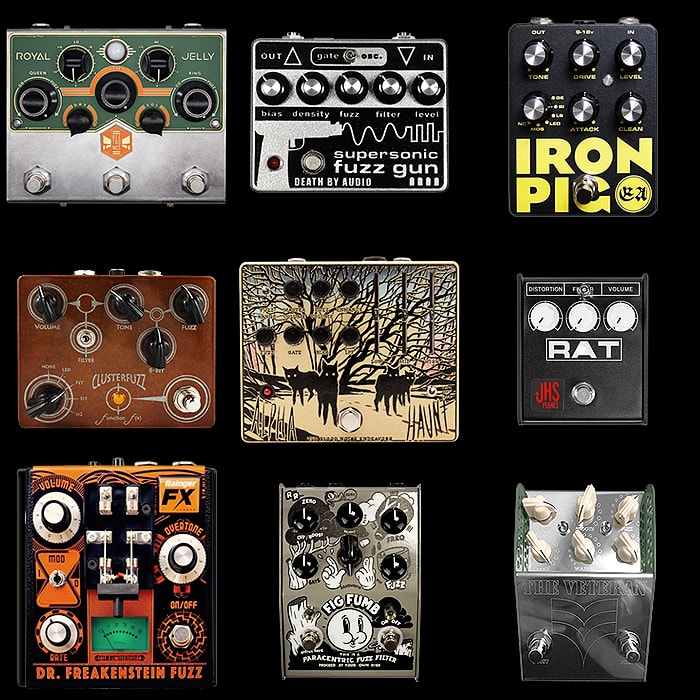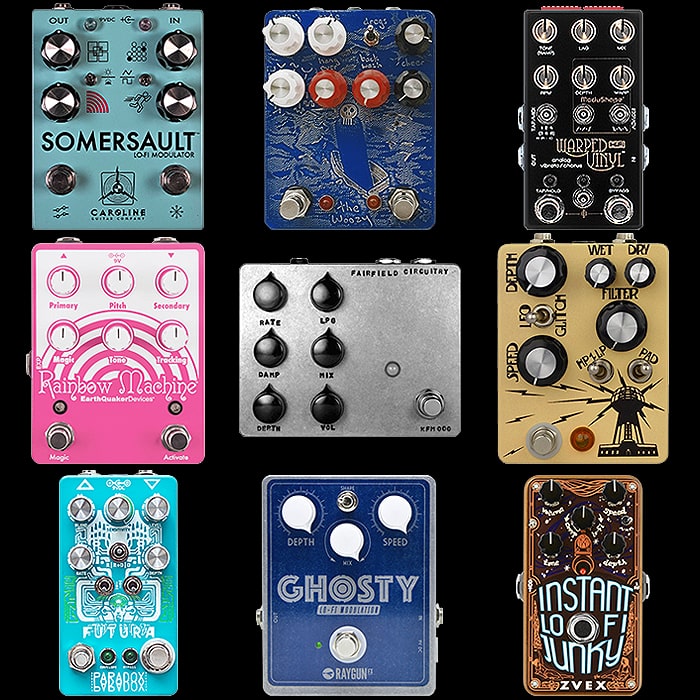The Best New Pedals In and Around Winter NAMM 2019 Show
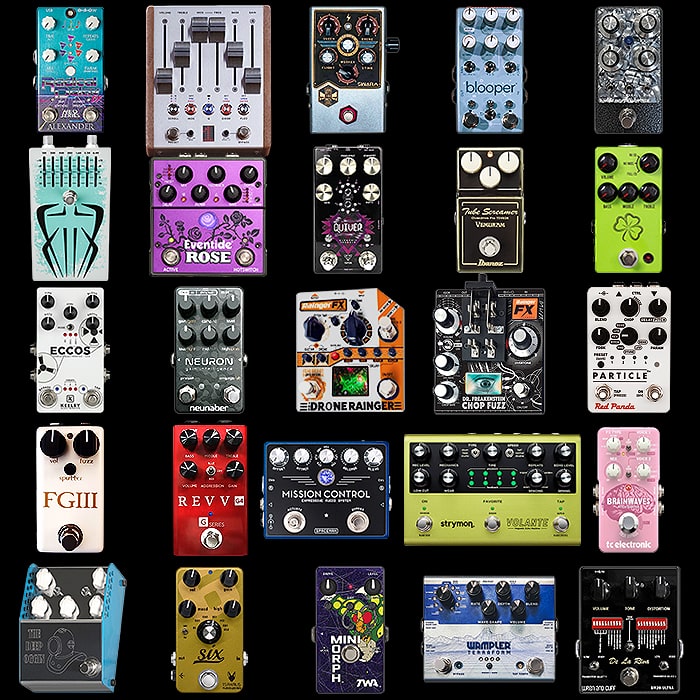
This year’s show has seen a bumper crop of interesting new pedals. In fact I was so dazzled by all the various cool pedals that I did not take note of much else - actually not entirely as there were a few synths weirdly that I liked the look of - including the new Teenage Engineering Modular Series in particular. There were very few guitars or amps though that properly piqued my interest.
Special thanks to Delicious Audio / Stombox Exhibit / 60 Cycle Hum and Premier Guitar in particular for their excellent pedal coverage and Andertons for their amusing encounters.
In terms of Pedals though - I think the new Chase Bliss Audio / Benson Amps Collaboration - the Automatone PreAmp MKII definitely stole the show - as I called it in my feature article from 5 days ago. Another heavy hitter already known to us was the Strymon Volante Delay, but there were plenty more surprises besides.
I really like the look of the forthcoming Beetronics Compact Schumann PLL-style - The ’Swarm’ - which crams 7 dials into that compact enclosure - looks suitably sharp as always. David Rainger of Rainger FX launched an updated version of his legendary Dr Freakenstein Oscillating Fuzz - now with additional square wave modulation + dial, he also launched a really cool dual-drone digital delay with momentary white noise effect - the ingenious Drone Rainger. Pretty much every category was well represented and all my usual favourite pedal-makers unveiled something worthwhile.
A few of these pedals have already been released and are ’Available Now’ while the vast majority will appear / be shipped in the next few months - with some unlikely to see light much before Autumn - including the really desirable and undoubtedly super pricey PreAmp II.
I list my whole longlist od pedals below - preceded by my top 25 Highlights - per the above image - most of those were obvious for me, although I had to make a tough decision on one or two. As Phillip McKnight mentions in his own show overview - one thing that seems to be a clear trend is that prices are generally ramping upwards - with most of the stand-out pedals this year sitting in the $200-$300+ price range, and some quite a bit more. As with all pedal development - if the pedals are not available yet it is generally tricky to call exact shipping dates - so I’ve extrapolated the existing data and estimated the likeliest ball parks - some of these are more precise, others will be more amorphous.
A couple of examples pertaining to long periods of development - firstly a pedal which was first introduced in Winter NAMM 2017 - The Foxpedal Quiver Tremolo - has only just now announced that a final production-ready model is complete - which means still several months to go to get the product finally out. A similar thing is happening to the much in-demand Empress Zoia - which was introduced at the 2018 Winter NAMM, then again at Summer NAMM, and sort of promised for the end of last year. The latest on the Zoia is that it’s still nowhere near final production and Empress will launch it as and when it is ready whenever that might be - so still a number of months of development and finessing required there.
Of those pedals listed I already have two - the Red Witch Fuzz God III (en-route actually) and the REVV G4 which arrived from Canada on the 10th. I’ve already mentioned that I will definitely be getting the Strymon Volante which is due on these shores in March - several Americans have already taken delivery of theirs.
The pedals that are definitely on my ’will get’ list are:
- Automataone PreAmp MKII
- Beetronics Swarm Harmonizer PLL Fuzz
- Demon Pedals Kondo Shifuku D-Style Drive
- Red Panda Particle V2 Granular Delay
- Red Witch Fuzz God III
- REVV G4 Distortion
- Strymon Volante Magnetic Echo Machine
Those on the Quite Likely List include:
- Chase Bliss Audio Blooper Modulated Looper
- Ibanez/Vemuram TSV808 Tube Screamer Overdrive Pro (silly price though!)
- JHS Clover ’Edge’-style PreAmp / EQ
- Neunaber Neuron Gain Intelligence PreAmp
- Rainger FX Dr Freakenstein Chop Fuzz
- Rainger FX Drone Rainger Digital Delay
- TC Electronic Brainwaves Pitch Shifter
- Tsakalis Six Multi-Voice Boost/Overdrive/Distortion
- TWA Mini Morph Modulated Fuzz/Distortion
- Wren and Cuff De La Riva BM20-Ultra Muff-Style Fuzz
And the remaining ones are on my really nice to have but probably not essential list!:
- Alexander Pedals Radical Delay DX
- Dunlop Billy Gibbons Siete Santos Octavio Fuzz
- Eventide Rose Bit Bucket Modulated Delay
- Foxpedal Quiver Harmonic Tremolo
- Keeley Eccos Stereo Vintage Tape Flanger Delay
- Spaceman Effects Mission Control Expression Command Centre
- ThorpyFX The Deep Oggin Analog Chorus/Vibrato
- Wampler Terraform Stereo Modulation Workstation
Of those that did not quite make the top 25 - there are still some notable ones that may still end up in my collection eventually - I will highlight some of those ahead of that list (further below).
If I had to do a favourite 3 it would be as follows:
- Automatone PreAmp MKII
- Strymon Volante Magnetic Echo Machine
- Beetronics Swarm Harmonizer PLL Fuzz
Pedals are listed alphabetically in brand order:
Alexander Pedals Radical Delay DX - $199 (Ships February)
The recently NEO-fied Radical Delay sees 6 cool improved modes - Mod (Modulated), Bend (Pitch-shifted), Dual (Dual-tap delay lines), Rev (Reverse/Tape stop), Arp (Chiptune arpeggiation), and Dyna (Touch-Sensitive Dynamic delay). You get the usual secondary functions here including signal degradation via alternative 'Clock' function on each mode. There are 3 tap-divisions and onboard presets per the other NEO models - all-round a really cool and quirky digital delay - albeit mono output only - so not really that suitable for my own setup / rig.
Automatone PreAmp MKII - Est c$750 (Ships July +/-)
I've already written everything you need to about this fantastic pedal with automatic moving sliders - this PreAmp could be your main Boost, Overdrive, Distortion and Fuzz - as controlled by 30 possible presets which you can step between - and the sliders move to reflect the new settings. You have Mids On/Off and Order of Placement, Parametric Mids with Q bandwidth, Germanium and Silicon clipping modes and Open or Gated Fuzz. This pedal is at least 6 months away - still looks like there is some product perfecting to be done here, and there is obviously significant work to get to production models from working prototypes. I would assume that some parts of the mechanism here are potentially fragile / fallible - so some serious unit testing will be required along the way - I of course volunteer my services as a Beta Tester! Joel has warned that this will be the most expensive pedal he has ever made - currently the CBA Tonal Recall RKM and Thermae are $499 each - so I've estimated this new pedal at circa $750 - I really hope it comes under that, and I sincerely hope it does not cost much more!
Beetronics Swarm Harmonizer PLL Fuzz - Est £249 (Ships March/April +/-)
I've done a few features on Schumann PLL style pedals - and have been considering for a while the formerly most compact of those - EarthQuaker Devices' Data Corrupter which still has a few more bells and whistles than the Beetronics - while that one totally nails the form-factor - with its 7 smartly placed dials - 6 on top and one on the side. I'm a huge fuzz fan and this was the most interesting new fuzz this year - just about pipping the Fuzz God III and De La Riva. There's a huge range of tones possible from this relatively small box. This is a pretty unique fuzz pedal and well worth considering.
Chase Bliss Audio Blooper Modulating Looper - $349 (Ships April +/-)
I'm already an avowed Chase Bliss Audio fan - and although the lack of Stereo on these effects makes some of them difficult to accommodate within my own chain, I nevertheless have 6 to date - and mostly permanent features in my pedal-chain. This 'Knobs' collaboration looks like a more controllable version of Granular Micro Looper / Delay - not quite the same as Montreal Assembly's Count to Five - but somewhat along those lines - and with more controls and more modulation options. This is another pedal that is very much still in prototype mode - and Joel warns of several more months of revisions on this one until it is production ready. I'm not 100% convinced that I want or need one of these, but for me - pretty much all the Chase Bliss Audio pedals are worthwhile in one way or another. They are still my absolute favourite pedal format/layout.
Demon Pedals Kondo Shifuku D-Style Overdrive - €279 (Available Now)
This is another pedal I've featured several times already on the site. It was first announced for PreOrders at the start of December - and there are still no further updates available - so I'm expecting February March production release. This to my mind is the most authentic of the Compact format Dumble-Style pedals - with the usual 4 main dials - Drive, Volume, Tone, Accent, but also less typically the 3 different mode toggle switches. The first governing power amp feel and compression mostly - B (Bold), C (Clean), D (Drive); then Jazz or Rock Frequency/EQ Shift, and finally ODS or Steel option for different playback dynamics profiles - covering headroom, sustain, gain and compression. I've long been a fan of the Dumble ODS tones - and already have several pedals of that ilk, I except this one to become the main of those options.
Dunlop Billy Gibbons Siete Santos Octavio Fuzz - £220 (Ships ApriL +/-)
This is a rather unusual iteration of an Octavio Octave Fuzz - coming as it does with a 7-band EQ for a huge range of tonal possibilities. EHX does the pretty massive Graphic Fuzz, but that has 1 less band. The Siete Santos comes with maximum EQ tweakage, but does also come in the rather old-fashioned large wedge form factor - with the Level and Fuzz dials mounted on the rear face - so it sounds great, but has some historic ergonomic problems as far as I'm concerned - no doubt that this is a hugely capable fuzz that many should love.
Eventide Rose Modulated Bit Bucket Delay - £359 (Ships February)
Apart from their earlier Workstation Pedals, I often feel that Eventide make missteps with their interface designs - as is definitely the case with the H9 and for me with this new device. Admittedly here though all the necessary dials are top surface mounted (unlike the H9), the various secondary modes though are somewhat cryptically contained within just two banks of LEDs with two different sets of legends / symbols on either side - so not particularly symbolically visible from normal playing height - possibly more coloured LEDs could have been used to further reinforce differentiation - while the central Rose LED does actually change hue to represent certain modes - so you end up looking for answers in lots of different places - I feel that part could have been done better. Also, for my own needs this pedal seems to be distinctly Mono in and out, which sort of eliminates it from my own rig. The idea here though is to get as fully-functioning an analog style modulated delay from digital parts. Hence Eventide have named this a Bit Bucket Delay - as they modelled the inner workings of proper Bucket Brigade Device Chips - you have several modulation modes you can apply with Tap Tempo and Divisions. Possibly you can look at this as a more evolved version of Strymon's Brigadier Delay - although that is stereo out. Perhaps the Rose lets you use TRS Y splitter cables into a single socket - but I can't see any mention of that so far. It's no doubt a capable delay, but sits somewhat in an odd niche for me - it definitely sounds suitably great though.
Foxpedal Quiver Harmonic Tremolo - £299 (Ships April +/-)
This pedal seems to have languished in development hell for a couple of years now - something to do with issues on the Midi connectivity side. Those seem to have been solved now, and we finally have a production-ready model of this very capable Harmonic Tremolo. It does not have quite as many features as my CBA Gravitas or Stone Deaf Tremotron - but is definitely firmly within the upper echelon of the best compact Tremolo pedals - it will be interesting to see exactly how well this compares with my current recommended 12 Compact Tremolos when the first demos materialise. With 10 presets onboard, 5 waveforms, tap-tempo and 5 sub-divisions this pedals should give most Tremolo fans everything they need. I have already decreed that I don't need another Tremolo - if I were to get one, my likeliest choice would be one with Stereo Outputs - like Swindler Effects' Red Mountain. I am a big fan of Foxpedal effects though - and already have 4 of their very fine pedals in my collection - The City V2 TS Style OD, Defector Dual-Muff-Style Fuzz, Kingdom Combo V2 Klone, and Wrath V2 Rat-style Fuzzstortion - all excellent! Note that the above intro video is actually from the 2017 Show! I will update that when a more suitable one comes around.
Ibanez/Vemuram TSV808 Tube Screamer Overdrive Pro - £435 (Ships February)
I was really hoping for something more akin to the Boss/JHS Collaboration from a couple of years ago where their Angry Driver was priced in between those two companies' typical levels of pricing. While this Ibanez/Vemuram Collaboration seems to be even more expensive than the typical £400 Vemuram pedal. Contrary to what a lot of commentators are saying - this is not really just another re-re-reissue of a TS808. Ibanez and Vemuram engineers have worked together to combine the best aspects of their respective TS808 and Jan Ray pedals - meaning a generally much flatter EQ curve vs mid-hump boost, and you get a suitably green-hued / verdigris Vemuram Brass style enclosure (Ibanez Shaped though) with 2 additional internal diode clipping dip-switch options, and 2 external trim-pots for tweaking Saturation and Bass respectively. I feel that this would have been a much better proposition at around the £250 mark - I don't think many can justify this much outlay for a single essentially 3-knob overdrive pedal. Possibly these have been set up to be Inflationary Collector's Items - which just annoys the hell out of me - as they will be snapped up by trust-fund and hedge-fund types rather than proper musicians, and relegated to a role of mostly shelf-ware or Reverb.com extortion.
JHS Pedals Clover PreAmp/EQ - £195 (Ships February)
Based on Boss's long discontinued 1984 FA-1 FET PreAmp this was one of U2 Guitarist's The Edge's main tone ingredients for the 'Unforgettable Fire' and has supposedly retained a place in his rig ever since. It's at its heart an EQ-ing PreAmp - which is used to shape and enhance the tone of the Amp you play through - being able to change the core tonality really quite significantly or else be used to deliver a range of different tones that the Amp could never deliver on its own. In a not dissimilar way to the Automatone PreAmp MKII above - you can choose here to have No EQ, No Mids or Full EQ applied. The pedal then just has a single output Volume dial and of course the 3-band EQ. On the surface a relatively simple 3-band Overdrive, but because of how it's been tuned, it gives you an enormous range of tone and gain-sculpting options. I'm not sure exactly how I would apply this to my rig - possibly it could occasionally oust my Spaceman Mercury IV Germanium Harmonic Boost - but boy do I love that pedal - I still think I will end up getting this one eventually. And I'm still hoping for a JHS Kilt V3 with the extra options and boost footswitch from the V1 brought into the compact form factor!
Keeley Eccos Stereo Vintage Tape Flanger Delay - $249 (Ships March/April)
I was excited about this one at last year's Summer NAMM where is was sort of fake introduced - i.e. far from a fully working model. It has obviously taken a while to perfect this new digital platform which Robert intends to now use for V2 versions of a number of his existing pedals. The updated internals utilise a 224 bit processor which allows you to store every bit of usage data with a preset - dial settings, and even expression pedal parameters. It seems like Chase Bliss Audio, Keeley and Red Panda are all sharing notes as they are making use of very similar underlying technologies - even though they deploy them in different ways. The best thing for me about this delay is that it is fully stereo - I've been hoping that TC Electronic too start picking up on this trend utilising dual footswitches / tap-tempo and presets all within the compact form factor! In any case this is a really useful digital modulated tape style delay with all the essential parameters you need - and every which one of those can be controlled by an expression pedal. If you're tight on space on your pedalboard - this could be your favourite new delay!
Neunaber Neuron Gain Intelligence PreAmp, Compressor, Noise Gate & Cab Simulator - $299 (Ships April +/-)
I've asked the question and it still hasn't been answered as to what the underlying signal architecture is here - how much is digital and how much is analog - are they doing a Strymon here with an initial JFET transistor and then DSP applied for cascading gain stages, or are they doing more of Source Audio - with this being a full digital DSP variant. The few demos I've heard to date are still somewhat inconclusive - the gain / crunch sounds suitably nuanced, dynamic and rich - so I cannot be sure which side of the divide this pedal falls on - it does sound pretty great to my ears so far on the relatively scant evidence that is already available - I really want this pedal to succeed, but I'm also a touch annoyed at how cagey Neunaber are about their inner workings - everyone should take note of Strymon who are one of the few companies to fully and transparently tell you how their pedals work - but even they don't always quote the essential Power Supply / Current Draw figures. So a great multi-function drive pedals with lots of bells and whistles, but unconfirmed internals!
Rainger FX Dr Freakenstein Chop Fuzz - £229 (Available Now)
David Rainger is almost the embodiment of Beaker from the Muppet Show - the archetypal crazy experimental scientist and it's an image I think he willingly cultivates - the devices that evolve form his own particular fertile mind are simply stand-out in their uniqueness. And we sort of go full-circle here with a revision / evolution of his original signature Device - The Dr Freakenstein Fuzz - where we get an additional 'Chop Rate' dial which adds a suitably stuttery square wave modulation on top of the existing oscillation fuzz to give you a momentary judder via judicious deployment of the of course also included Igor expression pad. I already have a black limited edition variant of the original, but I really want this one too!
Rainger FX Drone Rainger Digital Delay - £229 (Available Now)
David's other new pedal is a dual frequency drone delay machine which you can punctuate with bursts of white noise via dedicated footswitch. Once again David has created an effect like no other - you can obviously tone things down and use this more simply - more like a normal delay - or you can get as weird as you want to. As a fuzz fan I'm more likely to acquire the Chop Fuzz above - but something about this one too really appeals. I would likely put this on rotation in my 'Glitch' effects slot which already has the Drolo Molecular Disruptor, Pladask Elektrisk Fabrikant, Montreal Assembly CT5 and KOG Mini Glitch on rotation. I have several more alternatives also earmarked for this slot - including the Red Panda Particle V2 mentioned below.
Red Panda Particle V2 Granular Delay - $299 (Ships February/March)
I confess that I was rather late to the Granular Delay / Micro Sampling / Looping / Splicing / Glitch party - and am now making up for lost time with relish. I am lucky in several ways that I've left it a little late - as I can benefit from much-improved and evolved versions of those pedals that I had been loosely tracking. With pedals you never know whether to hold off a little longer or twist now. First mover advantage is often a disadvantage in the pedal acquisition realm - as you often pay more for a lesser version of the pedal (allowing for later discounts) - where latter versions usually come with better graphics and colourways and more bells and whistles attached - at least about 99% of the time. Very occasionally a new version is a misstep into the wrong form factor, or some of the new features introduce some unwanted side effects - for the most part though the V2 is significantly improved - as is very much the case here. When looking at the feature set and form factor of the original I wasn't wholly won over - however the new Particle V2 with its more compact form factor, dual footswitches, onboard presets and numerous refinements raises this pedal for me from a nice to have - to a must have. I've been internally debating ownership of the Red Panda Tensor, but I think I prefer the Particle overall for my usage scenarios. I would probably give it a fairly decent rotation in the Glitch pedal slot.
Red Witch Fuzz God III - $130 (Available Now, 1st Batch Sold Out, 2nd Ships February)
This is one of the two pedals I've already acquired - albeit this one is still enroute to me weirdly from the USA - where I thought Red Witch was a New Zealand outfit? In any case this simple looking 3-knob fuzz has 6 dip-switches under the bonnet, 2 for gain-shaping, and 4 for tone-sculpting - which supposedly delivers most every kind of core fuzz type from a pair of BC109 Silicon Transistors. I wish Red Witch had learnt the same lesson as Xotic did with its mini pedals - as its two new ones listed in the longlist below - both feature external dip-switches in a CBA-style but on the side of the pedal rather than the rear face. Red Witch instruct you to set and forget - but as a Pedal Tweaker I love to experiment - and I've extensively made use of Alchemy Audio and JHS for their external switching mods. The hopefully forthcoming FG IV really has to follow the same model set by the new Xotic Effects Minis. Other than that I really look forward to getting mine and working at setting up the very best sounding fuzz.
REVV Amps G4 Distortion - £200 (Available Now)
This one arrived surprisingly early - and I took delivery from Canada on the 10th of this month. And while the G3 is Tight, Modern and Mid-Focused - the G4 is actually more brutal, thicker and fatter - with more gain and saturation, and a lot heavier low-end accompanying some suitably piercing frequencies at both ends of the spectrum. I find it a very suitable replacement for my much larger Diezel VH4-2, and although not exactly matching they sort of do similar things in the ballpark of what I want. I currently have a range of High Gain pedals in my pedal-chain - which currently includes the Strymon Sunset, Empress Heavy, MI Effects Megalith Delta, REVV G3 and REVV G4 in sort of ascending order of gain / saturation - and each with a different flavour of 'Heavy' - in fact you could probably add the Strymon Riverside to that list as I run its favourite mode in high gain too. I have several alternatives and understudy pedals for the two REVVs including the Abasi Pathos, Friedman BE-OD, Keeley Filaments, Lone Wolf F.O.A.M, Wampler Dracarys and Triple Wreck to name a few. At the top end of the saturation scale though my current champions are the two REVVs.
Spaceman Effects Mission Control Expression Command Centre - from $369 (Available Now)
I didn't quite get this pedal properly at all when I first encountered it or viewed all the available videos at the time of launch. It wasn't until I watched the Andy Martin overview (per above) that things clicked and I finally figured out what this pedal was about. We've seen quite a few utility pedals released of late - by EQD, JHS, Morley and now Spaceman Effect. What the Mission Control does is essentially a mini routing switching box where you can apply different expression ramping to the active loop. Spaceman Zak describes it as an Autofader, Signal Router, Dynamic Effects Loop, Wet/Dry Blender, Y-splitter, Two-channel Mixer, Customizable Tremolo, Buffer, and Interface for CV and Expression Control. You have various inputs and outputs, dual footswitches - Activate and ByPass (Momentary and Latching), alongside 5 key control dials - including a main 7-mode selector dial. The modes being GT (Gate) Up / Down, OS (One Shot) Up / Down, LF (LFO) Up / Down and TRG (Trigger). You essentially hit the Activate Footswitch to initiate the ramping and hit again to release or return to normal. The 4 other dials control the degree and dynamics of the ramping - Offset (Effect Level / Depth essentially), Attack (Rate of Activate Ramp), Release (Rate of Release Ramp), Blend (Dry/Wet Blend). Several commentators have described this as chiefly a sort of Automated Expression Pedal - where the pedal controls and smooths out the fade in/out ramp up/down of the expression effect. So a somewhat complicated explanation for a relatively simple pedal, I'm still not convinced I need one - but what it does is kind of cool.
Strymon Volante Magnetic Echo Machine - £399 (Available Now in US, Ships March in UK)
I've already done a feature on this - I feel it will take over as my main delay pedal for a while - ahead of the Empress EchoSystem and Strymon TimeLine. I've long been wanting a proper Stereo Echorec style delay - and the interface on this - along with the ability to assign feedback individually to each playback head even when it's not active is really ingenious. It has a super intuitive layout and presets - and 3 flavours of magnetic / tape style delay with all the right tone-sculpting options - Drum (Echorec), Tape (Echoplex / Space Echo) and Studio (Reel-to-Reel). Obviously this is just one flavour type overall of delay - but it's the one I personally use the most. I can also achieve Ping-Pong style dynamics by assigning different Left/Right panning values on each playback head via combining Feedback buttons and the Time control. The final feature here is how you can hold down the playback head buttons to cut playback level in half - thereby accentuating the other ones which are active - so there are all kinds of clever dynamic controls here which raise this pedal to the top of its particular category - it's not cheap, but it's sort of around the right price when everything is considered. If you like the Strymon El Capistan then Strymon describe the Volante as the El Cap on Steroid - I'm certainly sold on its merits.
TC Electronic Brainwaves Pitch Shifter - £99 (Ships March+/-)
It's heartening to see that even without Tore, TC Electronics is still capable of turning out impressive pedals in its core range - possibly one of his last involvements. I'm generally not impressed with the parent company, and the website and service experience has tanked since TC Electronic was taken over by Behringer / Music Group. This looks like a really good companion piece to the Quintessence Harmonizer and like a super EHX Pitchfork with bells on or a super compact DigiTech Whammy! You get 2 individual Voices that you can range up or down up to 2 octaves - with all the important in-between steps and a Custom option too. There are 7 modes / FX Types including Pitch, V1>V2, Wham, Detune and 3 TonePrints. The pedal is full stereo in/out and also comes equipped with Dry/Wet Blend Control and TC Electronic's relatively recent MASH dynamic pressure-sensitive Footswitch feature. I will probably get this for alternating rotation with the Quintessence - I actually feel that this pedal will likely be more useful for me - as the Quintessence can be a touch fiddly to set up! There are currently no demo videos available for this pedal, but there should be some soon, and I will add as soon as something materialises.
ThorpyFX Deep Oggin Analog Chorus/Vibrato - £250 (Ships March)
This is for sure a fantastic sounding lush watery analog Chorus/Vibrato and of the usual amazing high quality that ever one of Thorpy's pedals are. I'm not sure though that this is necessarily the one for me or for my rig - it's not stereo, and it does not have the tap-tempo feature that I really love on this sort of pedal - even though actually the next Chorus effect I intend to get is the recent Boss Waza Dimension C. My main Chorus is still likely to remain the Chase Bliss Audio Warped Vinyl MKII which I still have much love for! For Tone purists though looking for a vintage analog style Chorus - you really can't get much better than the Deep Oggin.
Tsakalis Six Boost, Overdrive & Distortion - €210 (Available Now)
I've not seen quite enough of this to make my mind up 100% but I'm certainly leaning well towards the positive side at the moment. This pedal is billed to cover BluesBreaker / KOT and Timmy tones - from light boost through Overdrive and Distortion - via 6 different modes - BS (Boost), OD1 Smooth Overdrive, OD2 Creamy Overdrive, DS1 Natural Amp Distortion, DS2 Amp Distortion with Bite and OD1+DS2 saturated Distortion. You have the usual 3 tone controls, albeit tone here is skewed towards the top-end 'High' while you also have 18V/9V Headroom options for more headroom or more compression settings. From what I've heard, this pedal has tonnes of its potential - I've just not heard quite enough yet to establish that it covers the entirety of that range equally brilliantly. I'm also currently 50/50 on whether I prefer this one or the very different but more feature-rich Neunaber Neuron - both cover vaguely similar ground but in totally different ways - and the Neunaber has much more digital trickery on tap - presets etc. I feel I'm unlikely to own both of these - I'm just not sure yet which way to go.
TWA Mini Morph Modulated Fuzz/Distortion - $189 (Ships March)
This is essentially a miniaturised and simplified version of TWA's well-received Dynamorph pedal - a core fuzz / fuzzstortion combined with an envelope-filter modulation. I already use Chorus, Phaser and Flanger to beef up my own distortions and fuzzes - so this is another variety of that kind of thing which I already really love. It's quite a simple concept really, but you have 5 different controls to shape the output - Drive, Level, Gain, Dry/Wet and More (Modulation). I really like the sound of this, and although not on my immediate priority wishlist this is something I will very likely acquire at some stage.
Wampler Terraform Stereo Modulation Workstation - Est $299 (Ships April +/-)
Currently still very much in prototype mode albeit a highly refined version - this will consist of 11 stereo modulation modes which are currently - Additive Flanger, Subtractive Flanger, TZF Through Zero Flanger, MXR-Style 90 Phase, Vibe (Uni-Vibe), Slow (Boss Slow Gear), Tremolo, Harmonic Tremolo, Dimension C Style Chorus, 3 Voice Chorus, Chorus - but Brian says these may be subject to change. You have 5 controls - Rate, Depth, Blend, Wave-Shape and Volume. The pedal features separate tap-tempo footswitch and onboard presets. The most incredible thing about this pedal is its size though - which is at the usual Wampler medium landscape format size - which is considerably smaller than the key competition - Strymon Mobius and Boss MD-500. I actually have the both the Strymon and the Boss and like each of those, so I'm not sure the Terraform is 100% for me - it does have the advantage in having all its controls on the surface - which is preferable for many players, but can be a limiting factor for avowed pedal tweakers. It certainly sounds up to the task, and is competitive in most ways - I still think I prefer the utility of triple footswitch pedals / bank up/down for these sorts of Workshop style pedals - but time will tell - certainly a very decent proposition. I think pricing may be a key factor here along with the size. This would also go up against the still very excellent Keeley Super Mod Workstation which is possibly its most obvious competitor.
Wren and Cuff De La Riva BM20-Ultra - $299 (Ships February/March)
This is kind of the Muff to end all Muffs! - with its dual pair of twin switchable Germanium and Silicon Transistors. You then get the classic 3 dial format - Volume, Tone, Distortion, but accompanied by no less than 20 external dip-switches which supposedly give you around 1 million permutations of tone and gain sculpting. This looks like a phenomenal proposition and I'm hoping some units make it into UK distribution as it's not usually economically sensible to buy the more expensive pedals from the US and pay the delivery and customs charges. I'm rather keen on this one - but it really does depend on availability to a degree - I might though be prepared to make an exception and order one direct to ensure I get a unit - I'm not sure I would want to miss out on this one.
The Full Longlist and Near Misses!
Of course in drawing a line in the sand for a top 25, some pedals unfortunately just missed the cut, and for most of those there were some heavy deliberations usually versus a couple of others covering similar ground. A great example of this is the new Greer Amps Soma '63 Vintage PreAmp where I chose the Neunaber Neuron and Tsakalis Six just ahead of that - even though the Soma went on to win a Best in Show award!
Other notable near misses include the trio of new and really quite affordable Laney / Black Country Customs Pedals - Steelpark Boost, Monolith Distortion and Secret Path Reverb; Mad Professor's Double Moon Analog Chorus, Flanger, Vibrato; the pretty much entirely revamped V2/V3 range from Matthews Effects; MXR's Dookie Drive; Origin Effects's Prototype Compact RevivalDrive; Paradox Effects' Futura Envelope Chorus; Peterson's StroboStomp HD Tuner Pedal; Pigtronix's Resotron Tracking Filter; Rob Chapman's new Snake Oil Fine Instruments The Very Thing Boost/Overdrive and Marvellous Engine Distortion, the various SolidGoldFX Prototypes and new iterations, and Xotic Effects cute new minis with smart external dip-switches - to name a few!
All in all there are 120+ pedals listed here, and this list is still not fully comprehensive - I'm sure there are a few I've overlooked and some possibly wrongly attributed to this timeframe too. In any case I will endeavour to keep this list up to date and add any omissions deemed notable!:
- A
- Alexander Pedals Radical Delay DX
- Amptweaker SwirlPool Jr
- Anasounds Element Analog Spring Reverb
- Automatone PreAmp MKII
- B
- Beetronics Swarm Harmonizer PLL Fuzz
- C
- Carl Martin Comp/Limiter
- Caroline Guitar Company Megabyte Lo-Fi Delay Computer
- Caroline Guitar Company Somersault Lo-Fi Modulator Chorus/Vibrato
- Catalinbread Coriolis Effect
- Chase Bliss Audio Blooper Looper
- Cooper FX Moment Machine Polyphonic Pitch Shifter / 16 Step Sequencer
- CopperSound Loma Pieta Harmonic Tremolo
- Crazy Tube Circuits Falcon dual circuit 5E3 Tweed Deluxe and 6G2 Brownface Princeton Overdrive
- Crazy Tube Circuits Limelight Fuzz/Distortion
- Crazy Tube Circuits Sidekick Chorus/Flanger + Delay + Reverb (80's / The Police in a box!)
- Cusack Music Screamer Fuzz
- D
- Danelectro The Breakdown Boost/PreAmp
- Danelectro The Eisenhower Octave Fuzz
- Datachoir + Old Blood Noise Endeavors Rêver Reverse Delay + Reverb
- Death By Audio Total Sonic Annihilation 2 Dual Feedback Fuzz Phaser
- Deep Space Devices Trigonaut Overdrive with Octave/Glitch/Stutter effects
- Demedash Effects T-120 Videotape Echo
- Demon Pedals Kondo Shifuku D-Style Overdrive
- Dunlop Billy Gibbons Siete Santos Octavio Fuzz
- Dwarfcraft Devices Body Mod Modulation Machine
- Dwarfcraft Devices Treeverb Trem-Verb
- E
- EarthQuaker Devices Swiss Things Pedalboard Reconciler
- Effectrode Blue Bottle John Verity Signature Inductorized Booster
- ElectroFaustus EF114 Simulacrum 4 Sample-Looper
- Electro-Harmonix Attack Decay Tape Reverse Simulator with Harmonic Fuzz
- Electro-Harmonix Flatiron Rat-Inspired Fuzz/Distortion
- Electro-Harmonix Mono Guitar Synth
- Electro-Harmonix SuperSwitcher Looper Switcher
- Empress Effects Zoia - still WIP
- Ernie Ball VPJR Volume Pedal + Tuner
- Eventide Rose Digital Delay
- F
- Fender Bubbler Chorus
- Fender Downtown Express Compressor, EQ, Overdrive
- Fender Lost Highway Phaser
- Fender MTG Tube Distortion
- Fender Tre-Verb Trem-Reverb
- Fender The Pinwheel Rotary Speaker
- Foxpedal Quiver Harmonic Tremolo
- Free The Tone Future Factory FF-1Y RF Phase Modulation Delay
- Fuzzrocious Pedals Heliotropic Fuzz + Octave Jawn Oscillator
- Fuzzrocious Pedals Knob Jawn Octaver
- Fuzzrocious Pedals Moth + Octave Jawn Fuzz/Distortion/Oscillator
- Fuzzrocious Pedals Playing Mantis Boost/Drive/Distortion/Oscillator
- G
- Gamechanger Audio Motor Pedal Prototype (Electro-Motor-Oscillation-Modulation)
- Glou Glou Moutarde Four Voice PLL
- Greer Amps Soma '63 Vintage PreAmp
- H
- Hotone Ampero Amp Modeller and Effects Processor Pedal
- Hungry Robot El Castillo Delay, Reverb & Pitch-Shifter
- I
- Ibanez/Vemuram TSV808 Tube Screamer
- Ibanez TS808 Tube Screamer Overdrive Pro in Red Sparkle
- J
- JAM Pedals Double Dreamer Dual Overdrive (Lucy Dreamer + Tube Dreamer)
- JAM Pedals Lucy Dreamer Overdrive
- JHS Pedals Active A/B/Y
- JHS Pedals Clover PreAmp/EQ
- JHS Pedals Summing Amp
- JHS Pedals Switchback
- JHS Pedals Whitey Tight
- Joe Gore Purr Vibrato
- Joyo R-02 TaiChi Dumble Style Overdrive
- Joyo R-03 Uzi High Gain Distortion
- Joyo R-05 Maximum Dual-Channel Overdrive
- Joyo R-07 Aquarius Delay Looper
- K
- Keeley DDR - Drive, Delay, Reverb
- Keeley Eccos Vintage Tape Flanger Delay
- Keeley Fuzz Bender Three Transistor Hybrid Fuzz
- Keeley Synth-1 Synth Wave Generator
- Keeley X Series Utilitarian 10 Pedal Range (Pete Cornish Grey Series Style)
- KRS Amplification Ceres 3 Channel PreAmp
- L
- Laney Black Country Customs Steelpark Boost
- Laney Black Country Customs Monolith Distortion
- Laney Black Country Customs Secret Path Reverb
- Lounsberry Pedals Tall Fat & Wide Stereo FET Clean Boost
- Lunastone Dynamic Delay
- M
- Mad Professor Double Moon Analog Chorus, Flanger, Vibrato
- Matthews Effects Architect V3 Overdrive
- Matthews Effects The Astronomer V2 Reverb
- Matthews Effects The Chemist V2 Chorus/Vibrato,Phaser, Octaver
- Matthews Effects Cosmonaut V2 Delay/Reverb
- Matthews Effects The Ghoul Fuzz
- Matthews Effects The Whaler V2 Fuzz
- Milkman Sounds F-Stop Trem-Verb
- Mod Duo X Audio Processor
- Mooer GE300 Amp Modelling, Synth & Multi Effects Pedal
- MXR Billie Joe Armstrong Dookie Drive (Dual Super Lead Blender)
- Mythos Pedals Argo Octave Fuzz
- Mythos Pedals Runestone Overdrive
- N
- Native Audio Catches Two Analog Voiced Tap Delay
- Neunaber Neuron Gain Intelligence Drive, Compressor, Cab Simulator
- Nexi Industries Skunk Anansie Drive Ace
- Nexi Industries Skunk Anansie Octavius Octave Up+Down
- Nexi Industries Orianthi Nexiplexi Drive
- Nexi Industries Orianthi Octaver Octave Up+Down
- Nux Horseman Overdrive
- O
- OneControl Silver Bee Overdrive
- Origin Effects Compact RevivalDrive Prototype
- Outlaw Effects The General Germanium Fuzz
- P
- Paradox Effects Fortissimo Ultra Linear Boost
- Paradox Effects Futura Envelope Chorus
- Peterson StroboStomp HD Tuner Pedal
- Pigtronix Resotron Tracking Filter
- Poly Effects Digit - Drive/Compression/Filter/Sequencer
- Poly Effects Morph - 4 Channel Delay and Reverb
- R
- Rabbit Hole FX OGOD Tube Overdrive/Amp Emulation
- RaingerFX Dr Freakenstein Chop Fuzz
- RaingerFX Drone Rainger Digital Delay
- Red Panda Particle V2
- Red Witch Fuzz God III
- REVV Amps G4 Distortion
- S
- Seymour Duncan Mark Holcomb Dark Sun Digital Delay + Reverb
- Shift Line A+ Prism-9 Filter Pad Pedal
- Snake Oil Fine Instruments Marvellous Engine Distortion
- Snake Oil Fine Instruments The Very Thing Boost and Overdrive
- SnK VHD Distortion PreAmp
- SolidGoldFX 76 Plus with Additional Filter Section
- SolidGoldFX Athena 2 Stage Asymmetric Phaser
- SolidGoldFX Communication Breakdown 1.5 + II Tone Bender Style Fuzz
- SolidGoldFX Imperial Germanium Fuzz
- SolidGolfFX Polyphonic Octave Down Filter Modulator Prototype X (To be Named)
- Source Audio Spectrum Intelligent Filter
- Spaceman Effects Mission Control Expression Command Centre
- Strymon Volante Magnetic Echo Machine
- Supro Analog Delay
- T
- Taurus Stomp-Head 1.VT Floor Amp
- TC Electronic Brainwaves Pitch Shifter
- TC Electronic June-60 Chorus
- Thermion Outlaw Boosted Delay
- Thermion Breakthru Overdrive
- ThorpyFX Deep Oggin Analog Chorus/Vibrato
- Tsakalis Six Boost, Overdrive & Distortion
- TWA Mini Morph Modulated Fuzz/Distortion
- Two Notes Le Lead PreAmp
- Two Notes Torpedo CAB M
- V
- Vanflet Distortion 1
- Vanflet Driver 1
- Vemuram Josh Smith Signature Myriad Fuzz
- Vemuram Shanks ODS-1 Drive
- W
- Walrus Audio Deepsix V3 Compressor
- Walrus Audio Lillian Multi-Stage Analog Phaser
- Walrus Audio Monument V2 Harmonic Tremolo
- Wampler Terraform Modulation Workstation
- Way Huge Smalls Supa-Lead Distortion
- Wren and Cuff De La Riva BM20-Ultra
- X
- Xotic Effects Super Clean Buffer
- Xotic Effects Super Sweet Booster
Final Thoughts
I thought I should tag on the new Gamechanger Audio Motor Pedal Prototype above - just for fun!
So this was definitely a vintage year for pedals as far as I'm concerned - do note that the top selection is obviously skewed towards my own preferences and towards those pedals I am most interested in and most likely to acquire. Those with different tastes may prefer other options. I am happy that I overlapped almost entirely with Andy Martin of Tone Report and Reverb.com fame for his choice picks - the only one we disagreed on was the Catalinbread Coriolis which did not impress me as much.
I think there are great new additions in most categories here, and a relatively high number of these will end up in my rotation at some stage. I will do an update of my Planned Pedal Chain evolution next - and may offer different variations of where that is likely to go. As mentioned above - I'm still eagerly awaiting the release of the Empress Zoia, and now must wait on a few more pedals. The most likely to arrive next is either the Strymon Volante or Kondo Shifuku with the other most desired ones a little further off.
As always I'm fascinated by the intention versus the eventual reality - as things rarely go entirely according to plan. Looking at the current pedal chain right now there really is not much wrong with it. I am slowly shifting from a Fuzz Focus to concentrating more on Glitch style pedals - and already have a number of those to my name - will probably get a MWFX Judder at some stage this year - and of course the Red Panda Particle V2, and I still have a soft spot for the Tensor.
I also still have a few pedals to catch up on from last year - so there will be some shifting of priorities and budgets! Something usually comes out of left field which catches you totally unawares and forces you to recalibrate everything. A key decisions I've made though is putting off the acquisition of the Line 6 HX Stomp to take the prime spot for Modulation Workstation ahead of the Boss MD-500 and Strymon Mobius. I actually keep discovering new Boss modes I really like - and with its Choruses, Filters, Flangers, Phasers and now Vibe - it's something I really enjoy using - so will keep that in pride of place for a while longer.
I've also decided that I really like all my Chase Bliss Audio analog modulations still, and although I will probably rotate in the Boss Dimension C Waza for the Warped Vinyl slot, the CBA pedals will still probably be the primaries. I did acquire the Zvex Vibrophase - which was great on clean tones, but did not really do what I needed for more gainey or distorted stuff - so back to the Wombtone again quite quickly! I still like the Vibrophase, but for how I use this slot, the CBA Wombtone is much more versatile and practical for my needs - I will retain the Vibrophase for more leisurely swirly tones.
Generally though, everything is going swimmingly - the pedal chain is mostly free of unwanted randomness and sounds truly magnificent most every day - tempered by mood and weather of course!







